It Fell From the Sky: Striking Imagery of Striking Events
The Tunguska Event
Though it flattened all the trees in every direction for 30 miles, the
airburst that took place over Siberia's Tunguska River left no crater
behind. Scientists theorize that the blast, caused probably by a meteor
or comet fragment that exploded a few miles over the surface of the
Earth, was 1000 times as powerful as the bomb that fell on Hiroshima,
Japan.
Otherworldly Object
It is believed that the Willamette meteorite crashed to the Earth
somewhere in Canada, but that it was shifted by a glacier south to
Oregon, where it was discovered in 1902. It is the largest meteorite
found in the United States, and the sixth largest in the world.
Impact Crater
Gosses Bluff, near Alice Springs, Australia was formed by the impact of a
meteor or comet about 143 million years ago. It is one of the
approximately 170 terrestrial impact craters on the Earth's surface.
Hole in the Desert
Much smaller and younger than Gosses Bluff, Arizona's Meteor Crater is
also known as Barringer Crater, in honor of Daniel Barringer, the man
who first suggested it was formed by the collision of a meteor with the
Arizona desert around 50,000 years ago.
Curiosity
Two Saudi men examine a two-ton meteorite embedded in the sand of the Kingdom's desolate Empty Quarter.
Meteor Shower
A time-lapse photograph captures the trails of two meteors in the sky
over Amman, Jordan. The red streaks at the mid left and bottom right are
meteors; the white streaks are stars. Most meteors disintegrate in the
intense heat created from entering the Earth's atmosphere.
Ring Shaped Reservoir
Water from a series of hydroelectric projects has filled Manicougan
Crater in northern Quebec to brimming. The resulting lake and the island
in its middle are sometimes called the "eye of Quebec."
Vast Expanse
It is believed that when Gosses Bluff crater was originally formed, it
measured over 13.5 miles in diameter. After 143 million years, much of
it has eroded away, leaving an exposed 3-mile wide formation.
Close Encounter
The Ahnighito Meteorite, at New York's American Museum of Natural
History, is one part of a much larger meteorite that fell to Earth
(landing in Greenland) thousands of years ago. Even so, at 34 tons, it
is the second largest meteorite in the world.
Concentric Rings
Aorounga Crater, in the Sahara Desert, northern Chad, is approximately
eight miles wide. It is believed to be several hundred million years
old.
Twin Craters
The Clearwater Lakes near Hudson Bay in Quebec were probably formed by a
binary asteroid, a system of two asteroids bound to each other by
gravity. This photograph was taken from aboard the Challenger space
shuttle in 1985.
Man and Crater
Earth experiences from one to three impacts large enough to produce a
12.5-mile diameter crater about once every million years, on average.
Does the Impact Rate For Asteroids Vary Periodically with Time?
Synopsis: Is the Earth more likely or less likely to be hit by an
asteroid or comet now as compared to, say, 20 million years ago? Several
studies have claimed to have found periodic variations, with the
probability of giant impacts increasing and decreasing in a regular
pattern. Now a new analysis by Coryn Bailer-Jones from the Max Planck
Institute for Astronomy (MPIA), set to be published in the Monthly Notes of the Royal Astronomical Society,
shows those simple periodic patterns to be statistical artifacts. His
results indicate either that the Earth is as likely to suffer a major
impact now as it was in the past, or that there has been a slight
increase in impact rate events over the past 250 million years. **
Giant impacts by comets or asteroids have been linked to several mass
extinction events on Earth, most famously to the demise of the dinosaurs
65 million years ago. Nearly 200 identifiable craters on the Earth's
surface, some of them hundreds of kilometers in diameter, bear witness
to these catastrophic collisions.
Understanding the way impact rates might have varied over time is not
just an academic question. It is an important ingredient when scientists
estimate the risk Earth currently faces from catastrophic cosmic
impacts.
Since the mid-1980s, a number of authors have claimed to have
identified periodic variations in the impact rate. Using crater data,
notably the age estimates for the different craters, they derive a
regular pattern where, every so-and-so-many million years (values vary
between 13 and 50 million years), an era with fewer impacts is followed
by an era with increased impact activity, and so on.
One proposed mechanism for these variations is the periodic motion of
our solar system relative to the main plane of the Milky Way Galaxy.
This could lead to differences in the way that the minute gravitational
influence of nearby stars tugs on the objects in the Oort cloud, a giant
repository of comets that forms a shell around the outer solar system,
nearly a light-year away from the Sun, leading to episodes in which more
comets than usual leave the Oort cloud to make their way into the inner
solar system -- and, potentially, towards a collision with the Earth. A
more spectacular proposal posits the existence of an as-yet undetected
companion star to the Sun, dubbed "Nemesis". Its highly elongated orbit,
the reasoning goes, would periodically bring Nemesis closer to the Oort
cloud, again triggering an increase in the number of comets setting
course for Earth.
For MPIA's Coryn-Bailer-Jones, these results are evidence not of
undiscovered cosmic phenomena, but of subtle pitfalls of traditional
("frequentist") statistical reasoning. Bailer-Jones: "There is a
tendency for people to find patterns in nature that do not exist.
Unfortunately, in certain situations traditional statistics plays to
that particular weakness."
That is why, for his analysis, Bailer-Jones chose an alternative way of
evaluating probabilities ("Bayesian statistics"), which avoids many of
the pitfalls that hamper the traditional analysis of impact crater data.
He found that simple periodic variations can be confidently ruled out.
Instead, there is a general trend: From about 250 million years ago to
the present, the impact rate, as judged by the number of craters of
different ages, increases steadily.
There are two possible explanations for this trend. Smaller craters
erode more easily, and older craters have had more time to erode away.
The trend could simply reflect the fact that larger, younger craters are
easier for us to find than smaller, older ones. "If we look only at
craters larger than 35 km and younger than 400 million years, which are
less affected by erosion and infilling, we find no such trend,"
Bailer-Jones explains.
On the other hand, at least part of the increasing impact rate could be
real. In fact, there are analyses of impact craters on the Moon, where
there are no natural geological processes leading to infilling and
erosion of craters, that point towards just such a trend.
Whatever the reason for the trend, simple periodic variations such as
those caused by Nemesis are laid to rest by Bailer-Jones' results. "From
the crater record there is no evidence for Nemesis. What remains is the
intriguing question of whether or not impacts have become ever more
frequent over the past 250 million years," he concludes.
Comet Garradd Caught on Camera
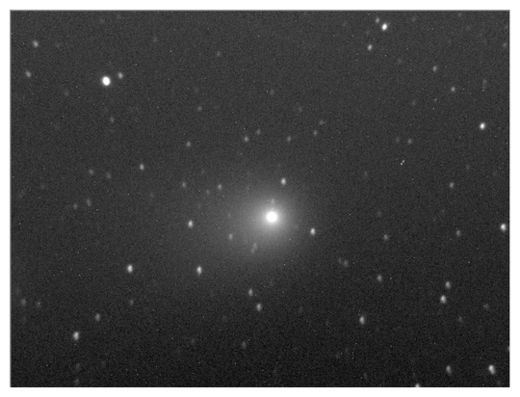
© The Daily Post, New Zealand
Comet:
Rotorua's Rolf Carstens captured this image of comet C/2009 P1
(Garradd) from his back garden on Homedale St on Monday morning.
Comet:
Rotorua's Rolf Carstens captured this image of comet C/2009 P1
(Garradd) from his back garden on Homedale St on Monday morning.
Rotorua's Rolf Carstens is a keen amateur astronomer and was up at
2.30am on Monday to capture this photo of recently-discovered comet
C/2009 P1 (Garradd).
The comet was discovered by Australian astronomer Gordon Garradd at
Siding Spring, New South Wales, in 2009 and can be seen in the eastern
skies of New Zealand.
The comet will come closest to Earth in March 2012 but will only be seen
in the North Hemisphere at that time. Scientists are still trying to
work out its orbit and when it will be near Earth in the future but,
according to Mr Carstens, that will be "a very long time".
Mr Carstens used a 25.4cm SCT (Schmidt Cassegrain Telescope) on a German
Equatorial Mount with a camera attached to take the picture from a
system remotely controlled from inside his house. He is also a member of
the Rotorua Astronomical Society, which has its next meeting tomorrow
from 7.30pm at the old Rotorua West Bowling Club building on Kamahi
Place.
Everyone is welcome.
Heavenly Signs: Chronicle of a Busy Month (July 2011)
Tucked
away safely down here on earth, the limits of our imagination is
confined to sci-fi films, and the odd natural disaster - ok increasingly natural disasters, but sometimes we do need to be reminded we are a part of something more...
July 2011 to date has been a busy time with that something more when it
comes to comets. The preoccupation with comets Elenin and Nibiru also
takes away from the comet show that has been taking place since the
beginning of the year, but has particularly busy in July 2011.
1st July - Ballyeaston, U.K. A fireball was sighted near the village, and reported to Armagh Observatory
1st July - 31st - U.S. - Across the U.S. 277 reports for July alone were recorded.
1st July - Dandenong, Australia - At 4.50am flames of green, blue, and yellow caught the attention of one witness.
1st July - Doveton, Australia - What looked like a faking star turned bright green and blue, then yellow before disappearing.
1st July - Melbourne, Australia - A huge green ball with a purple - white tail fell was witnessed.
1st July - Renfrewshire, Scotland - At
00:40 a blue colour meteor lit up the sky. It seems the same meteor
appeared blue-orange from Rhyl, North Wales, had a sparking green and
red coloured tail, which is a sign fragmentation from East Midlands at
23:37, and at low altitude from Bakewell in Derbyshire at 23:38.
5th July - Ballyclare, U.K. - Fireballs lit up the 11,00pm sky
6th July - Matawai, New Zealand - A
low flying bright meteor lit up the early morning (5.50am) sky, as
sparks from its orange-red tail were flying off it before a boom was
heard,
7th July - Poland - A comet registered
by the Poland Fireball Network had travelled cross most of the Polish
sky as recorded by an observatory station in the village of Podgorzyn
before fragmenting. Experts agree that it came from the area of Jupiter.
16th July 2011 - Kilimambago, Kenya. An
explosion was heard about 10am which was compared to a plane crash.
Eye-witness accounts saw it spinning on impact before landing in a
cornfield. Police and military found a hot smooth black object weighing
11 pounds.
30th July - Kabati, Kenya - At 9.00am
an explosion drew the attention of military personnel caused by an
object weighing 2 kilograms. The impact could be heard 5 km away
Sources:
American Meteor Society
Bright Fireballs Over Poland
Fireballs Spotted in the Sky
Meteorite Puts on Pre-Dawn Light Show
Mysterious Object Fell from the Sky
NASA Dawn Spacecraft Reveals New Insights into Mysterious Vesta Asteroid 184 Million Km Away From Earth
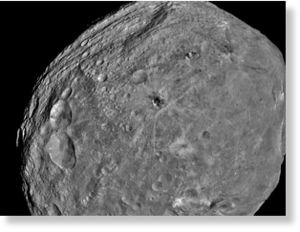
© NASA
NASA's Dawn
spacecraft is beginning the first of it four intensive research orbits,
with its initial run around the Vesta asteroid scheduled to begin on 11
August.
NASA's Dawn
spacecraft is beginning the first of it four intensive research orbits,
with its initial run around the Vesta asteroid scheduled to begin on 11
August.
NASA's Dawn spacecraft is beginning
the first of it four intensive research orbits, with its initial run
around the Vesta asteroid scheduled to begin on 11 August.
The spacecraft will soon begin circling the giant asteroid at an
altitude of roughly 1,700 miles, providing key data and in-depth
analysis of the Vesta giant.
Vesta is the brightest object viewable from Earth in the asteroid
cluster surrounding Earth, Mars, Venus and Mercury. Previously, little
was known about the giant though it is believed to be roughly 530
kilometres large in diameter. The Dawn has already taken an image of Vesta showing its its rocky outer surface for the first time in human history.
The images have all been taken while the Dawn is still roughly
5,200 km from the asteroid. NASA has since confirmed that the current
images are primarily for navigation rather than overtly scientific
purposes.
The report from NASA clarified that the Dawn has already been caught by the Vesta's gravitational pull and is now only 2,900 km away from the asteroid.
To get this far the Dawn has already had to travel 2.8 billion km. Launching all the way back in September 2007 it has taken the Dawn four-years to get to the first stage of its mission.
Once the Dawn gets close, as well as photographing Vesta, the
spacecraft will also be able to enact more in-depth investigations
utilizing its gamma ray and neutron detector and infrared mapping
spectrometer. The devices will allow the Dawn to measure the nature and energy of the subatomic particles emitted from and measure the mineralogy of the asteroid's surface.
Marc Rayman, Dawn's chief engineer and mission manager at
NASA's Jet Propulsion Laboratory in Pasadena California commented on the
Dawn's most recent pictures: "Now that we are in orbit around one of
the last unexplored worlds in the inner solar system, we can see that
it's a unique and fascinating place."
With Jim Green, planetary division director at NASA Headquarters in
Washington adding: "The new observations of Vesta are an inspirational
reminder of the wonders unveiled through ongoing exploration of our
solar system."
The news follows NASA's recently announced new mission, that hopes to have astronauts land on a near-Earth asteroid by the year 2025.
First opal-like crystals discovered in meteorite
Scientists have found opal-like crystals in the Tagish Lake
meteorite, which fell to Earth in Canada in 2000. This is the first
extraterrestrial discovery of these unusual crystals, which may have
formed in the primordial cloud of dust that produced the sun and planets
of our solar system 4.6 billion years ago, according to a report in the
Journal of the American Chemical Society.
Katsuo Tsukamoto and colleagues say that colloidal crystals such as
opals, which form as an orderly array of particles, are of great
interest to for their potential use in new electronics and optical
devices. Surprisingly, the crystals in the meteorite are composed of
magnetite, which scientists thought could not assemble into such a
crystal because magnetic attractions might pack the atoms together too
tightly. "We believe that, if synthesized, magnetite colloidal crystals
have promising potential as a novel functional material," the article
notes.
The formation of colloidal crystals in the meteorite implies
that several conditions must have existed when they formed. "First, a
certain amount of solution water must have been present in the meteorite
to disperse the colloidal particles," the report explains. "The
solution water must have been confined in small voids, in which
colloidal crystallization takes place. These conditions, along with
evidence from similar meteorites, suggest that the crystals may have
formed 4.6 billion years ago."
Meteorite and Explosion Over South-Western France
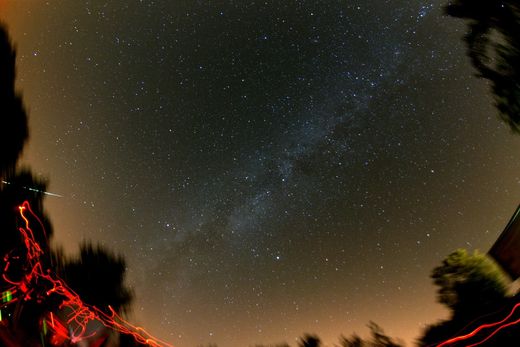
© David Néel
This photo was taken 20 km from Clermont-Ferrand (Isserteaux) - the meteor's trajectory was a westerly direction.
This photo was taken 20 km from Clermont-Ferrand (Isserteaux) - the meteor's trajectory was a westerly direction.
Several
people reported seeing a green object with a yellow or white tail
yesterday (August 2nd) at 3.35am in the skies above Toulouse, France.
"It was 3. 35am on Tuesday morning. I had just looked at my watch as I
was heading out to do my round when I looked up at the dark sky and, for
about 3 seconds, saw a large, silent green object with a light trailing
behind it. About 30 seconds later I there was an loud explosion as if
something had hit the ground", says Alexandre, a security agent working
at the Toulouse military airport. "It wasn't a plane. I know well that
there are no flight paths in the area of the sky where I saw it. It
looked like a firework, but silent and a a lot bigger. A colleague who
was outside smoking a cigarette saw it too." he added.
Alexandre has 4500 'friends' on Facebook. He reported his sighting on
the social networking site. One of his 'friends' sent him a message:
"She was unable to sleep last night and saw the same thing as me, with a
white light. Another person from Albi saw it too. For me, it looked
like a meteorite", explained the security agent.
Yesterday afternoon, Le Geipan, an unidentified aerospace phenomena
study and information group, which collects all information on UFOs in
France, received two other eyewitness accounts of the same phenomenon at
the same time.
The Niue police chief says a large bang heard around the island late
on Tuesday night sounded like thunder but may have been a meteor
exploding.
Mark Chenery says the island has been abuzz about the loud noise and
inquiries made at Wellington's Carter observatory suggest it was
probably caused by a meteor detonating about 20 kilometres above Niue.
Mr Chenery says he initially thought a boat had blown up down at the wharf.
"There was a large, a huge clap of thunder but it was its normal starry
night outside. People have described seeing a white light, like a flare,
shooting across the sky. Niue is 64 kilometres around and it was heard
in Lakepa in the north west down to Avasele in the south east, so it was
certainly heard island wide."
Mark Chenery says there have been no reports of damage.
Now in the Night Sky: Comet Garradd
If
you haven't already, it's time to start looking for Comet Garradd! This
comet, with the nomenclature C/2009 P1, is now coming into small
telescope/binocular view so here's your chance to see the brightest
comet in the current night sky. You can find it in the late evening sky
in the constellation Pegasus. Viewing it now, Garradd is just coming out
the "fuzzball" stage, and its tail is just coming into view.
Some say it's much better looking than that other comet, Elenin, that
has been needlessly grabbing some headlines. Comet Garradd was
discovered two years ago by Gordon Garradd from the Siding Spring
Observatory in Australia, and is currently visible through a small
telescope at about magnitude nine.
Above is an image of Comet Garradd from Peter Lake (aka Astroswanny) from Australia.
Throughout the next couple of months, Comet Garradd will get
higher and brighter and cut through the Summer Triangle north of Altair.
By September, it will drop lower in the west but remain visible in the
evening sky until year's end for observers at mid-northern latitudes.
Comet Garradd will peak in brightness late next February at around 6th
magnitude, so it could be visible with the naked eye if you have really
dark skies. Closest approach to Earth happens next March 5, when Garradd
will be 117.7 million miles away. At that time, the comet will be seen
flying though the Little Dipper.
Other comets are also currently falling towards the Sun and brightening
as they get closer include C/2010 X1 (Elenin), expected to peak near
magnitude six in early September, 45P/Honda-Mrkos-Pajdusakova expected
to peak brighten past magnitude eight in mid-August, and C/2011 L4
(PANSTARRS) which may become visible to the unaided eye during the early
months of 2013.
Bearing in mind I know nothing of comets, I initially thought it
might be one. I googled for other sightings and haven't found anything
as yet. I did find Asteroid 2011MD but that wasn't due to go past till
27 June 2011. What's your opinion? One of the above? Meteorite? Some
kind of UFO? We're stumped and really surprised there's been nothing in
the media about it.
An
exploding meteor was believed to be responsible for a huge bang that
reverberated around the Pacific island nation of Niue last week,
according to police.
Niue police chief Mark Chenery said the loud bang on Wednesday night
woke the island's 1,200 residents and he initially thought a boat had
exploded in the harbour.
Chenery said there was widespread speculation about the cause of the
noise but the Carter observatory in New Zealand had told him it was
likely to be a meteor exploding 20 kilometres (12.5 miles) high in the
atmosphere.
"There was a large (noise), a huge clap of thunder but it was its normal starry night outside," he told Radio New Zealand.
"People have described seeing a white light, like a flare, shooting
across the sky. Niue is 64 kilometres around and it was heard in Lakepa
in the northwest down to Avasele in the southeast, so it was certainly
heard island-wide."
Chenery said there were no reports of damage.
--
Source: Agence France Presse
An exploding meteor was believed to be responsible for a huge bang
that reverberated around the Pacific island of Niue last week.
Niue police chief Mark Chenery said the loud bang on Wednesday night
woke the island's 1,200 residents and he initially thought a boat had
exploded in the harbour.
Mr Chenery said there was widespread speculation about the cause of the
noise, but the Carter Observatory in New Zealand has told him it was likely to be a meteor exploding 20 kilometres above the Earth.
"There was a large (noise), a huge clap of thunder, but it was
its normal starry night outside," he told Radio New Zealand.
"People have described seeing a white light, like a flare, shooting
across the sky. Niue is 64 kilometres around and it was heard in Lakepa
in the north-west down to Avasele in the south-east, so it was certainly
heard island-wide."
Mr Chenery said there were no reports of damage.
Meteor Streaks Across Sky Over Hungary
A flaming meteor streaked over Hungary late Friday evening, according to eyewitness accounts on several websites.
Weather portal Idokep.hu put the meteor over Western Hungary at 9:46pm,
based on eyewitness accounts by several hundred readers who watched it
move across the sky for 3-4 seconds. A loud explosion could be heard
near Lake Balaton a few minutes later.
The meteor was moving in a northeasterly direction, according to an eyewitness account posted on the homepage of the Nagykanizsa Amateur Astronomers Association, based in southwest Hungary. "It appeared so close that we almost started looking for the meteorite," the eyewitness said.
Other accounts posted online show the ball of fire was visible from Budapest and as far east as the city of Miskolc.

© Darren Mills / GFW Advertiser
A
meteor, space junk, satellite or alien spacecraft? A number of people,
including Harold Watkins, saw what appeared to be a fireball Monday
night in Botwood. He said the object had been moving west and
disappeared behind Bishop's Falls, and did not have a tail behind it.
One possibility is that the object was a communications satellite with a
bright reflective surface.
A
meteor, space junk, satellite or alien spacecraft? A number of people,
including Harold Watkins, saw what appeared to be a fireball Monday
night in Botwood. He said the object had been moving west and
disappeared behind Bishop's Falls, and did not have a tail behind it.
One possibility is that the object was a communications satellite with a
bright reflective surface.
Whatever it was, Harold Watkins and others in Botwood were treated
to the sight of what appeared to be a fireball in the sky Monday night.
"I live in an apartment off Twomey Drive, and this lady said to me,
'look, do you see that over there?' and when I looked, it seemed to be
one big ball of fire going west," he said. "It was about 1,000 feet in
the air. It looked very close to us."
Mr. Watkins and others had returned from Botwood Day ceremonies that
evening, which had included fireworks at the Botwood Airbase. But he and
the other people who had returned to outside his apartment said the
fireworks had finished by the time they left the base.
"It was going west, and looked like it would have ended up in the back
of Bishop's Falls," he said. "There were three of us coming back from
the base and just getting out of the car. And the lady next door in an
apartment next to me said 'see that in the air,' and when I looked, it
was one big ball of fire and it was moving around and around."
Ron Silver, a media representative for NAV Canada, responsible for air
traffic control operations across the country, said he contacted ATV at
Gander International Airport after he was notified of the incident by
the Advertiser.
"They didn't report anything unusual," he said.
Besides the far-fetched possibility of alien spacecraft, the most likely
possibilities are space junk, such as trash from old spacecraft and
decommissioned satellites and meteors, all burning up on re-entry in
Earth's atmosphere.
"Although we're still 10 days from the peak of the Perseid meteor shower, you can
get meteors and fireballs anytime," said Randy Dodge, secretary of the
St. John's centre of the Royal Astronomical Society of Canada (RASC).
The Perseids are regular meteor showers, which happen when Earth's orbit
brings the planet through a body of "dust" leftovers from broken-up
comets and other astral remains.
It's quite possible, however, what the observers was a functioning
satellite, which many people from all walks of life have mistaken for
meteors or even UFOs.
"It could be an Iridium 55 phone satellite," said Garry Dymond, auditor
with the St. John's RASC and also a regular tracker of meteors and
satellites. "It was visible from your site at about (10:30 p.m.) at a
magnitude of -8, bright enough to cause you to see your shadow on the
ground. Venus has a magnitude of -4 and the full moon has a magnitude of
-12. It came from the northeast heading west, and its orbit is 770
kilometres. There were a few -8 visible satellites from your area that
night and the next. The description of the flight line having no tail
but getting bright and then dimming makes me believe that what they saw
was an Iridium satellite and the sight they saw is referred to as an
Iridium Flare."
The Iridium communication satellites are oddly shaped, with three
polished door-sized antennas at different angles. The forward antenna
faces the direction the satellite is traveling. Occasionally, an antenna
reflects sunlight directly down at Earth, creating a quickly moving
illuminated spot on the surface below of about 10 kilometres in
diameter. To an observer this looks like a bright flash, or flare in the
sky, lasting for about a few seconds.
Comet Collision to Come?
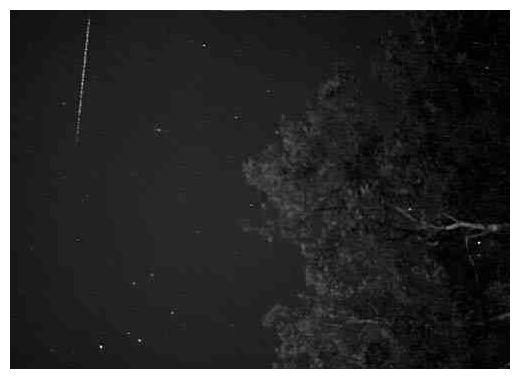
© CAMS / SETI
This
+2 magnitude February eta Draconid was filmed by Peter Jenniskens with
one of the low-light-level video cameras of the Cameras for Allsky
Meteor Surveillance (CAMS) station in Mountain View, California, at
07:59:24 UT on February 4, 2011.
This
+2 magnitude February eta Draconid was filmed by Peter Jenniskens with
one of the low-light-level video cameras of the Cameras for Allsky
Meteor Surveillance (CAMS) station in Mountain View, California, at
07:59:24 UT on February 4, 2011.
A telegram was issued
on July 10th by the Central Bureau for Astronomical Telegrams of the
International Astronomical Union announcing that the Earth got impacted
for a few hours by a stream of dust from a potentially dangerous comet last February 4.
"This particular shower happens only once or twice every sixty years,"
says discoverer Dr. Peter Jenniskens of the SETI Institute and NASA
Ames. "The stream of dust is always there, but quite invisible just
outside of Earth's orbit. Only when the planets steer the dust in
Earth's path do we get to know it is there."
Jenniskens heads the Cameras for Allsky Meteor Surveillance (CAMS)
project in California. Since last October, the SETI Institute has
teamed up with Fremont Peak Observatory and UCO/Lick Observatory in
monitoring the night sky with low-light video cameras in an effort to
map the meteor showers in the sky over the San Francisco Bay Area. They
triangulate the meteor trajectories and determine their orbit in space.
The International Astronomical Union keeps score of showers
that were claimed to exist in the past and now has a list of 300+
showers that need confirmation. Only 64 showers have been established so
far. Jenniskens' goal is to establish many more.
While reducing the Fremont Peak and Mountain View station observations
from February 4, normally a night with not much going for it, Jenniskens
discovered a handful of meteoroids that arrived at Earth from the exact
same direction in the sky. The meteoroids arrived from the direction of
the star Eta Draconis, and the shower is now recognized by the
International Astronomical Union as the February Eta Draconids (FEDs for
short). This was the first new shower discovered in the CAMS project,
and a very unusual one at that.
The meteoroids in question were moving on a very elongated orbit, typical of that of long-period comets such as Hale-Bopp.
Unlike Hale-Bopp, this one passes close to Earth's orbit. Long-period
comets come back to the Sun only rarely and if any one is on a
trajectory to hit the Earth, we could have little warning.
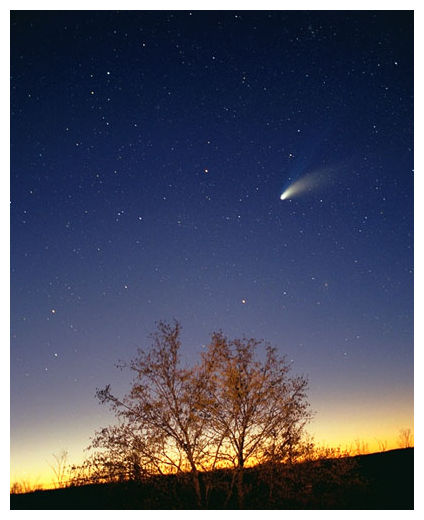
© Philipp Salzgeber
The meteoroids were moving on a very elongated orbit, typical of long-period comets like Hale-Bopp (pictured above).
The meteoroids were moving on a very elongated orbit, typical of long-period comets like Hale-Bopp (pictured above).
Now,
Jenniskens has found the trail of crumbs of such a comet, which passed
very close to Earth's orbit the last time it was near the Sun. That
could have been only a few hundred years ago, or many thousands. At that
time, the comet released a cloud of dust which is now returning. Some
dust grains return earlier than others, depending on how elongated their
orbit ended up being, and the result is a continuous stream of
returning dust grains. That stream is detected only when it encounters
the Earth, when the meteoroids cause a brief 2-hour meteor shower.
"Earth gets hosed typically only once or twice every sixty years by such
streams," says Jenniskens. "Only when Jupiter and Saturn are back at
their original positions do they steer the dust trail in our path. The
trail wags in and out of Earth's path much like the Sun moves around in
response to the motion of these heavy planets."
The February Eta Draconids follow a short list of other such known
showers, which include the November 22 Alpha Monocerotids, which were
seen last in 1995, and the September 1 Aurigids, which created a
spectacular shower in 2007. The return of those showers was predicted by
Jenniskens.
Now the February Eta Draconid shower has been discovered, Jenniskens is
confident that a next return can be predicted. He teamed with Finnish
astronomer Esko Lyytinen to investigate. Lyytinen calculated a possible
return in 2016 or 2023, after that not again until 2076.
Future observations of this shower may pry loose other information about
the comet that caused this stream of meteoroids, which is a potential
danger to Earth. "If the meteoroids can hit us, so can the comet," says
Jenniskens, "We don't know whether the comet has already passed us by or
is still on approach." To get some extra advance warning, one could
look along the measured orbit to those spots where the comet could arrive at Earth's orbit on a future February 4 date.
"Even then, chances are very small that the comet will actually hit us, as such impacts are rare in Earth's history," he added.
Source: SETI Institute press release.
Earth is entering a stream of debris from Comet Swift-Tuttle, source of the annual Perseid meteor shower. International observers are now reporting nearly 20 Perseids per hour, a number that will increase as the shower reaches its peak on August 12-13.
After midnight on August 10th, Marco Langbroek caught this early Perseid
flying over his moonlit roof in Leiden, the Netherlands:
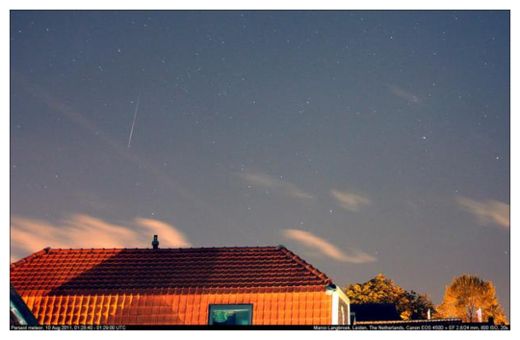
© Marco Langbroek
Conditions
were very dynamic, with fast moving cloud fields. During a clearing, I
captured this Perseid (10 Aug 2011 between 01:28:40 - 01:29:00 UTC) low
in the west. Canon EOS 450D + EF 2.8/24mm lens, 800 ISO, 20s exposure,
Leiden town center.
Conditions
were very dynamic, with fast moving cloud fields. During a clearing, I
captured this Perseid (10 Aug 2011 between 01:28:40 - 01:29:00 UTC) low
in the west. Canon EOS 450D + EF 2.8/24mm lens, 800 ISO, 20s exposure,
Leiden town center.
On the same night in Dayton, Ohio, photographer John Chumak recorded a flurry of Perseids.
"More than 3 dozen bright meteors rained down over my observatory last
night!" he says. "Many were brighter than I expected, so there is still a
chance for folks to see some Perseids despite the glare of the bright
Moon."
The best time to look is Saturday morning, Aug. 13, just before
dawn when the Moon is low and meteor rates are peaking. Some observers
will also see the International Space Station, which coincidentally
flies over many US towns and cities during the shower's peak: ISS tracker. Also, be sure to tune into Space Weather Radio
to hear the ghostly pings of Perseids disintegrating over the US Air
Force's Space Surveillance Radar. It makes a great soundtrack for any
meteor watch.
A NASA spacecraft aimed at the sun shifted its unblinking gaze to
an approaching comet last week to snap a new photo of the icy object as
it flew by.
The image shows the comet Elenin
as it passed within 4.3 million miles (7 million kilometers) of one of
NASA's twin Stereo sun-watching spacecraft during a series of deep space
photo sessions that began on Aug. 1. NASA rolled the Stereo-B satellite
to give its instruments a view of the comet flyby, officials said.
From Stereo's observations, the fuzzy comet Elenin can be seen streaking
across a small portion of the sky. The comet was seen by Stereo's HI-2
telescope between Aug. 1 to 5, and by the higher resolution HI-1
telescope between Aug. 6 to 12, NASA officials said. Stereo mission
scientists planned to take photos for one-hour every day through Aug.
12.
"From August 15 onward, the comet enters the HI-1 telescope's nominal
field of view, at which time we should enjoy continuous viewing of the
comet," NASA researchers explained in an update posted to the Stereo
mission website.
Comet Elenin is expected to become brighter over the next few
days, and could be detectable using Stereo's coronagraph instrument
between Aug. 20 and Sept. 1, NASA officials said. Mission managers are
then expecting the comet to become visible to another sun-watching
spacecraft - NASA's Solar and Heliospheric Observatory (SOHO) - for
six days, beginning on Sept. 23.
Comet Elenin was discovered in December by Russian astronomer Leonid
Elenin, who spotted the icy wanderer using the International Scientific
Optical Network's robotic observatory near Mayhill, New Mexico.
Viewed from Earth, comet Elenin presently appears as a faint smudge of
light in deep sky exposures. By late August the comet could be visible
to the naked eye as a dim "fuzzy star" with a tail.
Comet Elenin will fly through the inner solar system in October 2011 and
be 22 million miles (35 million kilometers) away at its closest
approach to our planet, NASA scientists have said. The comet is not
expected to be particularly dazzling, but the flyby may be a good chance
to study a relatively young comet from the outer solar system.
Some doomsday theorists have pinned the Nibiru rogue planet hypothesis on the small comet.
Conspiracy theorists say a planet, known as Nibiru, will swing in from
the outskirts of our solar system and collide with Earth and wipe out
humanity in 2012. Since no rogue planet has been found in the outer
solar system, some people have argued that comet Elenin will be the true
culprit in the Nibiru-Earth collision.
NASA has dismissed the notion that comet Elenin is anything other than a
dim, wimpy comet. It poses no threat to Earth, making its closest pass
at a distance roughly 100 times farther than the distance from Earth to
the moon.
NASA's identical twin Stereo spacecraft were launched in October 2006.
They are offset from one another, one flying ahead of the Earth and the
other behind. The name "Stereo" is short for Solar Terrestrial Relations
Observatory.
Speedy Comet Honda to pass near Earth next week
It wasn't but a week ago I was observing Comet
Honda-Mrkos-Pajdusakova, which for simplicity we'll call Comet
Honda-M-P. It was very low in the southern sky in the early morning
hours and a tough catch in the constellation Pisces Austrinus
the Southern Fish. Using the "lure" of time, I made two observations -
one around midnight and the other at 2 a.m. This way I was able to
track and positively identify a faint, round hazy glow that slowly
inched across the starfield over the span of two hours. Terry's photo
below captures its appearance well.

© Terry Lovejoy
Comet Honda-Mrkos-Pajdusakova photographed by Australian amateur astronomer Terry Lovejoy on August 5.
Comet Honda-Mrkos-Pajdusakova photographed by Australian amateur astronomer Terry Lovejoy on August 5.
Sure
wasn't much to look at, but finding an old friend is always a pleasure.
I last saw the comet back in 2001 and before that in 1995. Honda-M-P is
what astronomers call a returning or periodic comet, similar to
Halley's Comet but with a much smaller orbit and hence a shorter times
between returns. It was discovered by Japanese amateur astronomer Minoru
Honda in 1948 and seen at nearly the same time by astronomers Antonin
Mrkos and Ludmila Pajdusakova.
Honda belongs to the short-period Jupiter family of comets or
those with orbits less than 20 years under the control of the
gravitational powerhouse Jupiter. As it orbits the sun with a period of
5.3 years, it occasionally makes close passes to the planets Venus,
Earth and Jupiter. When near Jupiter, the planet's powerful gravity can
alter the comet's orbit and change its period slightly. This last
occurred in 1983 and will again in 2030.

© Chris Marriott's SkyMap
Comet
Honda-M-P covers a lot of ground in the next week, plunging through the
southern constellations Grus, Tucana, Hydrus and Dorado as seen from
Australia.
Comet
Honda-M-P covers a lot of ground in the next week, plunging through the
southern constellations Grus, Tucana, Hydrus and Dorado as seen from
Australia.
Next Monday August 15, Honda will pass very
close to the Earth - relatively speaking - at a distance of just
5.6 million miles. To put this in perspective, that's 23 times farther
than the moon or still a long ways off. I've been asked if the comet
will affect the Earth in any way, and the answer is 'no'. Honda is only
0.6 miles across and far too tiny to produce any measurable effects on
our much more massive planet. If anything, it's the other way around.
Earth may very slightly alter the comet's orbit.
When I saw the Comet Honda-M-P, it was very faint in a large amateur
telescope (15-inch). Today it's brighter at magnitude 8.5 with a coma or
cometary atmosphere measuring about half the size of the full moon.
If you're worried that Earth might pass through the coma, don't be. At
Honda's present distance of 9.3 million miles, the hazy glow around the
tiny cometary nucleus is about 43,000 miles across, much too small to
reach out and brush our planet. Even if we did pass through a comet's
outer coma, its effects would likely amount to a nice show of meteors at
best. Comas are highly rarefied - any ice, dust or small rocks would
quickly vaporize on striking the upper atmosphere.
The closer a celestial object is to Earth, the faster it appears to move
across the sky. Because the comet is closing in on minimum distance
from Earth, it's quickly picking up speed, covering more and more ground
as we approach the 15th. Tonight for instance, it travels some two
degrees or four times the full moon's diameter in the southern
constellation of Grus the Crane. Tomorrow that increases to three
degrees, and by the 14-15th, Honda-M-P flys across some 10 degrees of
sky- your clenched fist held at arm's length - in just one night!
The next night or two, the comet will still be visible from the far
southern states low in the south around 1 a.m., but by the 14th, only
southern hemisphere observers will see it. To spot the comet, you'll
need at least a small telescope, since it's very diffuse and will get no
brighter than 8th magnitude. The moon will also be near or at full
phase, lighting up the sky and making it even harder to find.
After
closest approach, Honda-M-P swings back north and slowly continues to
brighten, reaching 6th magnitude (naked eye limit) in late September,
and finally appearing in the morning sky before dawn for northern
hemisphere sky watchers in early October. It's expected to be an easy
binocular comet then, shining around 7th magnitude.
On the morning of the Oct. 7, it will be joined by Comet Elenin four
degrees (eight full moons) to its north. Although both comets will be at
different distances from Earth - 90 million miles for Honda-M-P and
22 million for Elenin - they'll lie in approximately the same line of
sight. With wide-field binoculars you'll be able to catch them both in
the same field of view. What a wonderful and rare sight this will be!
Speaking of Comet Elenin, southern observers continue to observe and
photograph it. It's now magnitude 9 with a 3-4 arc minute coma and
visible in 4-inch and larger telescopes. Click HERE for the latest views of the comet with the STEREO-B (behind) solar telescope.
Mystery surrounds what made the earth tremble across Norfolk in a bizarre late-night phenomenon.
Experts and amateurs alike believe a sonic boom - triggered by a
meteorite or aircraft - caused strange tremors to shake homes and
spook pets.
The rattling was reported by people across the county, including
Norwich, North Walsham, Gayton, Belton, Cringleford and South Lopham at
about 10.30pm on Tuesday.
Jonathan Larter, from Sprowston, said: "I was just going to bed and the
house started shaking and doors rumbling as if the wind was blowing
through the windows, but they weren't open. I thought it was a ghost
outside knocking on my door because I live near a cemetery."
Alan Sharman, from City Road, Norwich, added: "My French doors rattled
rather loudly at 10.30-ish. It actually sounded like someone was trying
to get in. It woke me up a bit."
Experts quickly dismissed the possibility of the movement being
caused by an earthquake as their equipment did not pick up any seismic
activity.
Glen Ford, a seismologist with the British Geological Survey, said:
"From the descriptions and the lack of seismic information ,it sounds
like it could have been a sonic boom."
Mr Ford said sonic booms can be caused by aircraft or meteorites. And in
a bizarre coincidence some people reported seeing a meteor over the
skies of Norwich just before the tremor started.
Dominic Hyde-Smith, 44, spotted "a streak of fire" land south of the city while on his way home to Hempnall.
"It just shot down in a split second," he said. "Rather than a shooting star, this went straight down towards the ground."
Meanwhile, RAF Marham staff said aircraft were not out on Tuesday but
planes from RAF Lakenheath were reported to have been on exercise.
Do you have a theory about what made the earth tremble? Email newsdesk@archant.co.uk
DNA in Space? Biological Building Blocks Found in Meteorites

© Chris Smith / NASA's Goddard Space Flight Center
Meteorites contain a large variety of nucleobases, an essential building block of DNA
Meteorites contain a large variety of nucleobases, an essential building block of DNA
Scientists
have been finding evidence of life inside meteorites for well over 100
years - that, or the building blocks of life. The claims of life have
been debunked every time, most recently just this past March. It always turns out to be a wishful interpretation of chemicals, minerals and tiny structures inside the meteorite that could be the fossilized husks of long-dead bacteria - but almost certainly aren't.
The building blocks, though, have proved a lot more convincing. As far
back as the 1960s, it was clear that amino acids, which link up to form
proteins, can and do form in space. And now scientists at NASA's Goddard
Space Flight Center in Greenbelt, Md., are claiming that another set of
molecules crucial to life have also rained down on Earth: adenine and
guanine, two of the four so-called nucleobases that, along with cytosine
and thymine, form the rungs of DNA's ladder-like structure.
By itself, that wouldn't mean much, says Michael Callahan, lead author of a new paper in Proceedings of the National Academy of Sciences.
"People have been finding nucleobases in meteorites since the late
1960s," he says. But they've always been among the handful of
nucleobases common to organisms on Earth, so contamination on the ground
after the meteorite landed has been the most likely explanation. "When I
picked up on this research," says Callahan, a chemist with Goddard's
Astrobiology Analytical Laboratory, "I was convinced that it was all
contamination."
But once he and his collaborators got hold of samples from 12
meteorites that had landed mostly in Antarctica and ran them through the
lab's liquid chromatograph and mass spectrometer, they discovered all
sorts of other molecules - substances that were similar in structure
but not biologically useful. That was a surprise; if a meteorite picked
up its biological traces on the ground, the adenine and guanine would
have been accompanied by other, equally familiar molecules - not these
substances that were not quite nucleobases but not quite not either.
"That," says Callahan, "argues against the idea that someone sneezed on
the meteorites." Another argument against earthly contamination is that
when the scientists took samples of ice and soil from the sites where
the meteorites were found, they saw the usual terrestrial mix of organic
molecules but not their nonbiological cousins. If the molecules came
from the landing sites rather than from space, you'd expect to see the
nonbiological cousins as well.
A third line of evidence comes from the fact that life-related
substances are common in space. Hydrogen cyanide, ammonia and water -
critical to building biology - are known to exist throughout the
cosmos, and when you mix them together in a lab, says Callahan, "it's
pretty easy to make nucleobases." It's not even a little bit of a
stretch to imagine that the same processes could happen on, or in, a
meteorite. It's also at least plausible that life would never have
arisen on our planet without a liberal dose of space chemicals,
delivered to Earth on a barrage of meteorites billions of years ago.
The new research doesn't address the question of panspermia,
the not entirely crazy idea that life arrived on our planet fully
formed as viruses or bacteria that developed on another world. If that
turns out to be the case - if we find microbes on Mars or on a
meteorite, for example, with DNA identical to ours - we might face the
disturbing fact that we're the contamination on a formerly pristine
planet.
What the new research does is reinforce an idea that astronomers and
biologists - and, increasingly, the people who call themselves
astrobiologists - find very convincing: since the raw materials of
life are common in the universe, and since we now know that planets are
common as well, it's hard to imagine how the Milky Way could not be teeming with life. Our species may continue to be special in a lot of ways - but perhaps a little less so than we thought.
One of the most dazzling shows of the year is upon us, but don't
worry - you won't need a ticket to see it live. A front-row view is as
close as your own backyard.
The annual Perseid meteor shower takes centre stage this week, painting
the night sky with glowing streaks of light. The spectacle begins every
year in mid-July and lasts through August, but the best time to take in
the show this year is when the meteor shower peaks on Friday night and
early Saturday.
Unfortunately, the glare of the full moon will make it hard to see some
of the more modest meteors this year. The best viewing time is expected
to be just before dawn on Saturday, when the moon will be low in the
sky.
The Perseids appear to originate from a point within the constellation
Perseus. The number of meteors visible in the sky tends to increase as
the night wears on.
According to NASA, more than a dozen meteors per hour were already visible by Tuesday.
For those who don't want to stay up until dawn, the few meteors
that are visible early in the night may also be some of the most
brilliant. Astronomers call these meteors earthgrazers. Long, slow and
colourful, they approach from the horizon and skim along the atmosphere
much to the viewer's delight.
The show is free, so grab a seat, whether for an hour or the whole
night, and if you miss the event this year you can always catch it again
next August. This performance has a standing engagement.
Meteor showers occur when the Earth encounters the debris fields left
behind by visiting comets. As comets travel through space and near the
sun, small particles of rock and metal break off, leaving fragments in
their wake like a trail of crumbs.
For example, the Perseids streak through the sky when the Earth is
passing through debris from Comet Swift-Tuttle. Comet crumbs called
meteoroids hit the top of Earth's atmosphere at hundreds of thousands of
kilometres per hour, burning up because of friction. This may make them
glow for several seconds, lighting up the night sky.
If a part of the meteor survives the trip through the atmosphere and
hits the ground, it's a meteorite. But that is a rare occurrence.
Meteoroids are usually pretty small. According to NASA, most meteors
range in size from one millimetre to one centimetre in diameter, barely
more than a grain of sand. The light they produce while burning up,
however, is very intense and can be seen from hundreds of kilometres
away.
Many people call these celestial fireworks "shooting stars," but they really don't have anything to do with stars at all.
The intense light of a meteor breaking up is created when a dust
particle hits air molecules in the Earth's atmosphere. The impact
vapourizes the outer layers of the meteor, leaving a trail of iron,
magnesium and sodium.
When this trail of molecules makes subsequent impact with air molecules,
the electrons are "bashed" out of their regular orbit with their
corresponding nuclei, creating light in the process.
The colour of light produced depends upon the composition of the
meteorite. Iron particles produce yellow light; sodium particles produce
orange-yellow light; magnesium produces a blue-green light and silicon
atoms produce red light.
The debris from a comet travels in parallel lines, and when that hits
the Earth's atmosphere, it appears to originate from a single point,
just as parallel train tracks appear to converge to a single point.
The Perseids, for example, get their name from the constellation
Perseus, because that is where the shower appears to originate.
Similarly, November's Leonids appear to come from within the
constellation Leo, and December's Geminids appear to originate from
within the constellation Gemini.
Find the darkest spot you can, away from light pollution. Try to get
outside any settled area. In years where there is a bright moon, try to
position yourself so its light is shielded from your field of vision.
Meteors can appear anywhere in the night sky and they are safe to watch with the naked eye.
Meteorites
hold a record of the chemicals that existed in the early Solar System
and that may have been a crucial source of the organic compounds that
gave rise to life on Earth. Since the 1960s, scientists have been trying
to find proof that nucleobases, the building blocks of our genetic
material, came to Earth on meteorites. New research, published next week
in the Proceedings of the National Academy of Sciences, indicates that certain
nucleobases do reach the Earth from extraterrestrial sources, by way of
certain meteorites, and in greater diversity and quantity than
previously thought.
Extensive research has shown that amino acids, which string together to
form proteins, exist in space and have arrived on our planet piggybacked
on a type of organic-rich meteorite called carbonaceous chondrites. But
it has been difficult to similarly prove that the nucleobases found on
meteorite samples are not due to contamination from sources on Earth.
The research team, which included Jim Cleaves of Carnegie's Geophysical
Laboratory, used advanced spectroscopy techniques to purify and analyze
samples from 11 different carbonaceous chondrites and one ureilite, a
very rare type of meteorite with a different type of chemical
composition. This was the first time all but two of these meteorites had
been examined for nucleobases.
Two of the carbonaceous chondrites contained a diverse array of
nucleobases and compounds that are structurally similar, so-called
nucleobase analogs. Especially telling was the fact that three of these
nucleobase analogs are very rare in terrestrial biology. What's more,
significant concentrations of these nucleobases were not found in soil
and ice samples from the areas near where the meteorites were collected.
"Finding nucleobase compounds not typically found in Earth's
biochemistry strongly supports an extraterrestrial origin," Cleaves
said.
The team tested their conclusion with experiments to reproduce
nucleobases and analogs using chemical reactions of ammonia and cyanide,
which are common in space. Their lab-synthesized nucleobases were very
similar to those found in the carbonaceous chondrites, although the
relative abundances were different. This could be due to chemical and
thermal processing that the meteorite-origin nucleobases underwent while
traveling through space.
These results have far-reaching implications. The earliest forms of life
on Earth may have been assembled from materials delivered to Earth by
meteorites.
"This shows us that meteorites may have been molecular tool kits, which
provided the essential building blocks for life on Earth," Cleaves said.

© NASA/ESA
A
Hubble Space Telescope image of what is thought to be a head-on
collision between two asteroids travelling five times faster than a
rifle bullet. The collision created a meteorite that was found to
contain amino acids
A
Hubble Space Telescope image of what is thought to be a head-on
collision between two asteroids travelling five times faster than a
rifle bullet. The collision created a meteorite that was found to
contain amino acids
Life on Earth may have its origins in outer space, according to Nasa research.
Scientists have analysed meteorites that formed billions of years ago before falling to Earth.
The carbon-rich fragments were found to contain chemicals similar to one
of the key components of DNA, the building blocks of life.
Tests show that the presence of these chemicals cannot be explained away
by Earthly contamination, suggesting DNA's origins may lie in outer
space.
The find comes from U.S. scientists, predominantly Nasa researchers, who analysed the chemical make-up of 12 meteorites.
Writing in the journal Proceedings of the National Academy of Sciences, the researchers said their find has 'far-reaching implications'.
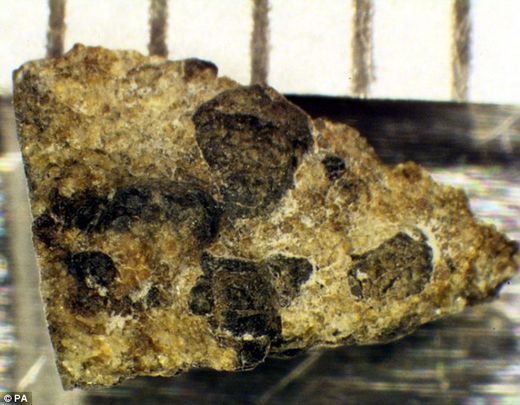
© PA
Life
from outer space? Scientists studying meteorites like this one say that
they could have brought the building blocks of life to Earth
Life
from outer space? Scientists studying meteorites like this one say that
they could have brought the building blocks of life to Earth
The
study's lead author, Dr Michael Callahan, of the Nasa Goddard Space
Flight Centre in Maryland, said: 'With meteorites and comets impacting
the early Earth, it appears that they did deliver some very important
ingredients.'
Previous studies found meteorites harbour the other two of the three basic ingredients of life.
These are amino acids, the 'beads' that form proteins when strung
together, and chemicals needed to allow cells to create a membrane
barrier. The chemicals in DNA are the third.
Lauderdale County Emergency Management received a report of a plane
possibly crashing Thursday night. But a search has not turned up
anything.
There may or may not have been a plane crash in Lauderdale County Thursday night. It's looking increasingly like there was not.
Emergency officials got a call around 10:30 p.m. from someone who
believed they saw a plane go down near the Newton- Lauderdale county
line.
They spent much of the night searching for the plane, and went back out Friday morning, but did not find anything.
"Just from what he described, and the fact that we had a meteor shower
last night during that time frame, I suspect we may be dealing with a
meteorite that fell," said Sharp. "I don't know that, but there's no
planes missing, anywhere around here. Nobody's reported anyone missing,
so I have to believe that's probably what we're dealing with."
A plane from the Mississippi Civil Air Patrol was also called in to check the area, but was not able to come up with anything.
We
made a wish that our readers would send in their images of the Perseid
Meteor Shower, and it came true! Despite a full Moon and clouds
scattered around the world, we heard from many of you that you saw -
and successfully imaged - the 2011 Perseids. Many of you took
advantage of Universe Today's new Flickr group,
an easy way to have readers share their astrophotos with us. Above is a
colorful image of a Perseid streaking through the sky by Nahum Mendez
Chazarra, in Rojales, Spain.
Below, see an image take from up above the world so high: astronaut Ron
Garan on board the International Space Station captured his view looking
down at a Perseid streaking through sky!
This is another Flickr submission, from Andrei Juravle, Timisoara, Romania. Click to see this image and more from Andrei.
Paul Miller from San Diego, California took the following two very nice images from Mt. Laguna:
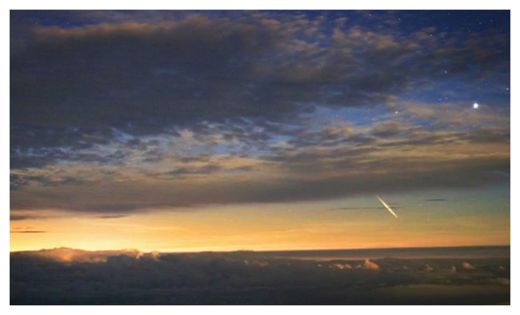
© Jason Major
A
Perseid meteor is caught on camera by the Canada-France-Hawaii
Telescope's mounted low-light Cloudcam before dawn on the morning of
August 12, 2011. Still frame cropped and edited by J. Major
A
Perseid meteor is caught on camera by the Canada-France-Hawaii
Telescope's mounted low-light Cloudcam before dawn on the morning of
August 12, 2011. Still frame cropped and edited by J. Major
Here's
one from our own Jason Major - kind of! He found the Perseid
streaking through the sky on footage from the Canada-France-Hawaii
Telescope's mounted low-light Cloudcam, and created this image.
How's
this for beginniner luck?! "Last night I captured my first ever Perseid
image with Andromeda on its upper left," said Leonard Ellul Mercer from
Malta. "This is the first time I tried imaging meteors. Was just lucky
even though there was a bright full moon overhead."
Keep imaging, Leonard - nice shot!
"I
took this on August 12, 2011 I'm not sure what it is," wrote in
Michaela Knott, "but I know it's not a plane (which is what most of what
shows up in my time lapse ends up being). This year I think I only saw 2
dozen or so meteors over two nights I went out looking."
Shot with a Nikon D60, 28mm lens f2.8 10 sec exposure at the Frosty Drew
Observatory in Charlestown RI, USA. "It was taken @ 9:42 EST, still
pretty early in the evening," Michaela said.
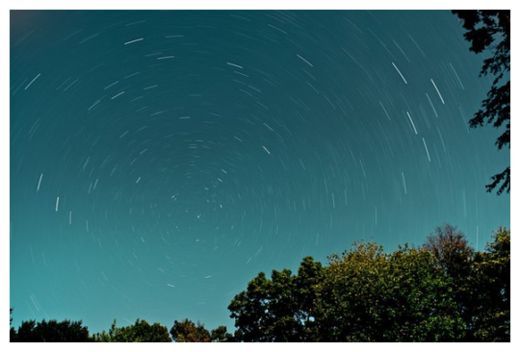
© David Parmet
Timelapse, Perseids and stars on August 12, 2011.
Sometimes photographers just happen to be in the right place at the right time to capture that magic moment.
If you are a Nasa astronaut you find yourself in that position a little
more often that amateur stargazers so Ron Garan makes good use of his
camera on duty to help us earthbound folk share in some of his special
experiences.
He took this stunning photograph of a Perseid meteor bursting into the
earth's atmosphere through a window of the International Space Station
on Sunday during the annual Perseid meteor shower.
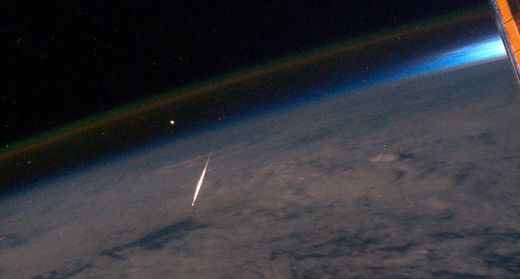
The astronaut posted his snap to Twitter with the
message: 'What a "Shooting Star" looks like #FromSpace Taken yesterday
during Perseids Meteor Shower...'
The
key difference in this image, which isn't immediately obvious from
looking at it, is that the Perseid meteor is moving away from Garan,
rather than towards him, as would be the case if the image was captured
on the ground.
Meteors are what remain of asteroids as the giant rocks hurtle through
space, breaking up as they smash into planets or burn up entering orbit.
The Perseids are grains of dust shed from the tail of Comet Swift-Tuttle burning up in the atmosphere.
They are named Perseid because they point where they come from - the constellation Perseus.
The annual Perseid meteor shower, which arrives every August, has been
observed by skywatchers for at least 2,000 years, according to Nasa.
This year's stunning light show began with sightings on Friday night,
kickstarting one of the highlights of the celestial year for amateur
astronomers.
Under ideal conditions up to 100 of the shooting stars an hour would have been visible when the shower peaked.
But Garan, who was launched into space as part of the Expedition 27 crew
in April, might have to watch the next one from terra firma as he is
nearing the end of his six-month stay on the ISS.
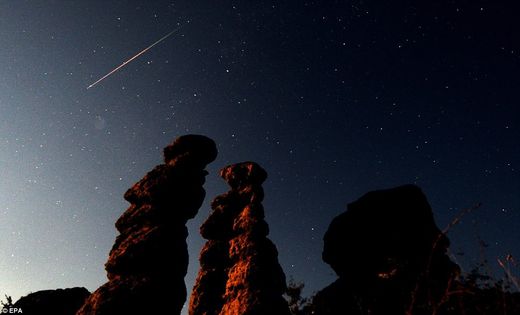
© Europäische Presse Agentur
Worm's
eye view: How a Perseid meteor looks from earth, taken in the night sky
over the stone dolls in Kuklice, near the eastern city of Kratovo,
Macedonia, on Saturday
Timelapse, Perseids and stars on August 12, 2011.
Sometimes photographers just happen to be in the right place at the right time to capture that magic moment.
If you are a Nasa astronaut you find yourself in that position a little
more often that amateur stargazers so Ron Garan makes good use of his
camera on duty to help us earthbound folk share in some of his special
experiences.
He took this stunning photograph of a Perseid meteor bursting into the
earth's atmosphere through a window of the International Space Station
on Sunday during the annual Perseid meteor shower.

© NASA/Ron Garan
Snap happy: Nasa astronaut Ron Garan took this photo of a Perseid meteor through a window in the International Space Station.
Snap happy: Nasa astronaut Ron Garan took this photo of a Perseid meteor through a window in the International Space Station.
The astronaut posted his snap to Twitter with the
message: 'What a "Shooting Star" looks like #FromSpace Taken yesterday
during Perseids Meteor Shower...'
The
key difference in this image, which isn't immediately obvious from
looking at it, is that the Perseid meteor is moving away from Garan,
rather than towards him, as would be the case if the image was captured
on the ground.
Meteors are what remain of asteroids as the giant rocks hurtle through
space, breaking up as they smash into planets or burn up entering orbit.
The Perseids are grains of dust shed from the tail of Comet Swift-Tuttle burning up in the atmosphere.
They are named Perseid because they point where they come from - the constellation Perseus.
The annual Perseid meteor shower, which arrives every August, has been
observed by skywatchers for at least 2,000 years, according to Nasa.
This year's stunning light show began with sightings on Friday night,
kickstarting one of the highlights of the celestial year for amateur
astronomers.
Under ideal conditions up to 100 of the shooting stars an hour would have been visible when the shower peaked.
But Garan, who was launched into space as part of the Expedition 27 crew
in April, might have to watch the next one from terra firma as he is
nearing the end of his six-month stay on the ISS.

© Europäische Presse Agentur
Worm's
eye view: How a Perseid meteor looks from earth, taken in the night sky
over the stone dolls in Kuklice, near the eastern city of Kratovo,
Macedonia, on Saturday
Meteors Sound Like Aliens!
A space radar picked up the sounds of a meteor shower as it delighted skywatchers over the weekend.
What do meteors sounds like as they hit Earth's atmosphere? From this
recording made by the U.S. Air Force Space Surveillance Radar in Texas,
the "pings" from the Perseid Meteor Shower sound rather alien! The radar
station in Lake Kickapoo, Texas is part of United States Strategic
Command's (USSTRATCOM), which involves detecting, tracking, cataloging
and identifying artificial objects orbiting Earth, such as both active
and inactive satellites, spent rocket bodies, or fragments of debris
from natural and man-made objects. Reportedly, the radar can detect
objects as small as 10 cm (four inches) at heights up to 30,000 km.
Capture Comet C2009 P1 Garradd Now
What are you waiting for? If it's an engraved invitation, the
consider this your pass to get out and start looking for Comet C/2009 P1
Garradd! It's well within reach of average binoculars and it's even in a
position that's easy for the average observer! Step on out here into
the backyard and I'll show you...
At
close to magnitude 8, Comet C/2009 P1 Garradd is currently grazing its
way along the eastern line of the Summer Triangle. Even if you live in a
moderately light polluted area, you should be able to make out the
three bright stars, Deneb to the north, Vega to the west and Altair to
the south. Just aim your binoculars roughly halfway between Altair and
Deneb and begin scanning on binocular field at a time for a faint, fuzzy
poofball that signifies the comet's presence. What you will see in
binoculars will appear to be like a "fuzzy star" - while a telescope
will reveal the beginnings of a tail.
Just check out the video taken by our friends at Bareket Observatory!
Did you catch the signature of a Perseid meteor in there, too? Good for you!
Now quit messing around on the computer and get out there and capture that comet!
Thanks to Bareket Observatory for the images and to heavens-above.com for the locator chart!
The third near-earth asteroid of 2011 will pass between the moon and earth later this year, NASA has confirmed.
The 575-foot-wide (175 metres) asteroid, which is more than one and a
half times the length of a soccer pitch, will pass within 0.85 lunar
distances of the Earth on November 8, 2011.
Discovered on December 28, 2005 by Robert McMillan of the Spacewatch
Program near Tucson, Arizona, 2005 YU55 is believed to be a very dark,
nearly spherical object.
According to NASA's Near Earth Object Program: "Although classified as a
potentially hazardous object, 2005 YU55 poses no threat of an Earth
collision over at least the next 100 years. However, this will be the
closest approach to date by an object this large that we know about in
advance and an event of this type will not happen again until 2028 when
asteroid (153814) 2001 WN5 will pass to within 0.6 lunar distances."
See Trajectory of Asteroid here.
While neither the European Space Agency (ESA) nor NASA has
suggested that YU55 poses a threat to Earth, plans to develop a mission
to counteract a potential asteroid collision in the future are already
underway.
The Daily Mail reported on Tuesday that the ESA is planning to
fire an 'impactor' satellite into a 'test' asteroid in 2015 to see if
the object's trajectory can be altered. The Agency is conducting the
test mission in light of the minimal threat posed by the 1,600-foot-wide
99942 Apophis asteroid, which has a one in 250,000 chance of impacting
Earth in 2036.
Other Recent Asteroid Encounters
In late June 2011, earth experienced one of its closest encounters with
an asteroid in recent years. But as NASA indicated in the days ahead of
the 'cosmic close call', the encounter was so close that Earth's gravity
sharply altered the asteroid's trajectory and prevented the space rock
from impacting the planet.
2011MD, a newly discovered asteroid passed within 12,000 kilometres
(7,500 miles) of Earth. The asteroid was only sighted for the first time
on 22 June by a robotic telescope in New Mexico, USA. The International
Astronomical Union's Minor Planet Center in Massachusetts, USA, put out
an alert Thursday.
It was daylight in the UK and Ireland (12.30 GMT) when the asteroid
passed over the southern Atlantic Ocean, near the coast of Antarctica.
The event was observable from South Africa and parts of Antarctica. It
also was visible in the hours leading up to the closest approach across
Australia, New Zealand, southern and eastern Asia, and the western
Pacific.
Some media outlets proclaimed the asteroid to be as big as New York's
Empire State Building'. In fact, 2011 MD measured about 16 feet to 35
feet.
According to Minor Planet Center's ranking charts 2011 MD's trip was the
fifth-closest recorded Asteroid event. The last asteroid to impact
earth was '2008 TC3' which was detected on 7 October 2008, just 19 hours
before it burned up in the atmosphere over northern Sudan.
On 2 June, a 10-metre wide asteroid passed between the earth and moon.
Asteroid 2009 BD, which was first observed on 16 January 2009 passed
approximately within 0.9 lunar distances (the distance between Earth and
the Moon) of earth. Astronomers believe the rock is a rare "co-orbital
asteroid" which follows the orbit of the Earth, not receding more than
0.1 AU (15 million km) away.
Two asteroids, several meters in diameter and in unrelated orbits,
passed within the moon's distance of Earth on September 8 2010. In April
2010 an asteroid roughly as long as a tennis court zoomed past Earth at
about the distance of the moon. The space rock to pass at or within
lunar distance previous to this was 2009 JL2, an asteroid about 17 to 37
metres across, in May 2009.
There is a roughly 50 percent chance of a 30-metre-wide plus asteroid
striking Earth each century, according to Clark Chapman, a space
scientist at the Southwest Research Institute in Boulder, Colorado, USA.
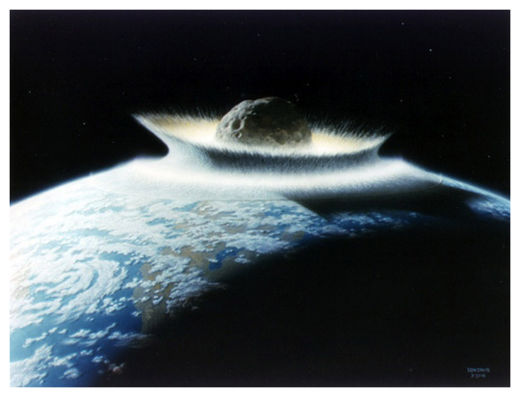
© Don Davis / NASA
Artist's
concept of a catastrophic asteroid impact with the early Earth. An
impact with a 500 kilometer (310 mile) diameter asteroid would
effectively sterilize the planet. The Earth may have experienced such
gigantic impacts in its youth, but fortunately today there are no
projectiles this large to threaten our planet.
Artist's
concept of a catastrophic asteroid impact with the early Earth. An
impact with a 500 kilometer (310 mile) diameter asteroid would
effectively sterilize the planet. The Earth may have experienced such
gigantic impacts in its youth, but fortunately today there are no
projectiles this large to threaten our planet.
For any single human being, there are bigger things to worry about
than death by space rock. For the long-term survival of humankind, on
the other hand, asteroids pose a real danger.
A 6-mile-wide asteroid that struck off the coast of present-day Mexico
65 million years ago induced ecological changes that wiped out the
dinosaurs. Inevitably, an Earth-shaking chunk of space debris will
strike again.
However, so many earthly worries exist that a cosmic one which, at any
given moment, is infinitesimally small doesn't garner much attention -
or government funding. Several scientists who study asteroid hazards
agree: Humankind probably won't start readying its planetary defenses
until we know the danger is real. We'll need evidence that a large
asteroid is actually headed here.
Will it be too late by then?
It depends. "Human beings can solve any technical problems that are put
in front of us," said Daniel Durda, senior planetary scientist at the
Southwest Research Institute in Boulder, Colo., and an expert on
asteroid collisions. "It's the social and political issues that we
struggle with." Rusty Schweickart, former NASA astronaut and founding
member of the B612 Foundation, a nonprofit organization dedicated to
protecting the Earth from asteroid strikes, concurred: "The geopolitical
realities are daunting. The technical issues are easy by comparison."
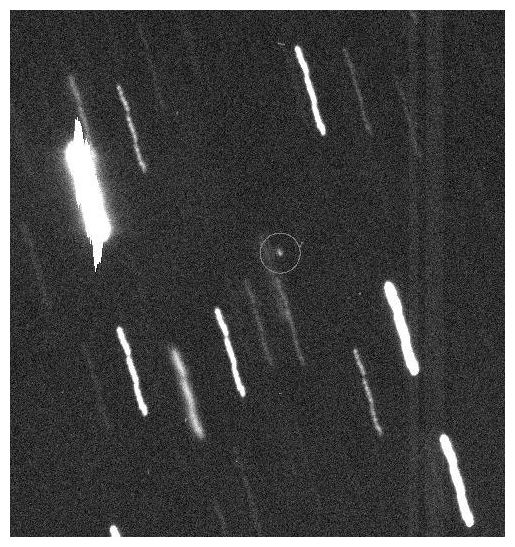
© UH / IA
The
asteroid Apophis was discovered on June 19, 2004. It will fly within
18,300 miles of Earth on April 13, 2029, but poses little risk of
impact.
The
asteroid Apophis was discovered on June 19, 2004. It will fly within
18,300 miles of Earth on April 13, 2029, but poses little risk of
impact.
The main culprits
Though we know very little about the composition of asteroids -
necessary information for determining their masses, and knowing how to
knock them off course - we do know where most of the large, nearby
rocks actually are. NASA's Spaceguard Survey tracks the paths of all
near-Earth asteroids (NEAs) in Earth's neighborhood that are larger than
1 kilometer (0.6 miles) in diameter.
Knowing an asteroid's location is step one in determining if it's on a
crash course for Earth, and fortunately, none of the big ones pose a
threat at this time. If one of these known asteroids were found to have a
greater than 1 percent chance of striking Earth, astronomers would
figure it out at least a decade beforehand.
"A large impact of something 1 km across - that's a bad enough
scenario that it would motivate people to take this seriously," Durda
said. According to Clark Chapman, another senior scientist at the
Southwest Research Institute, the international community would probably
band together and plan a mission to divert the path of the asteroid.
"This would probably require matching its orbit with a series of
spacecraft equipped with bombs," Chapman said. Getting the deflection
mission off the ground would cost on the order of $10 billion.
Though we don't have all the technology worked out yet, we do know how to build nuclear devices,
and we have already successfully sent spacecraft to and from asteroids.
"A decade out, given the technology it would take to do a deflection, I
think we could respond in time," Durda told Life's Little Mysteries, a
sister site to SPACE.com.
David Morrison, interim director of the NASA Lunar Science Institute and
an expert on impact hazards, thinks we might need more time. He
believes it would take two missions to deflect an asteroid. The first
would rendezvous with the target asteroid and figure out what it's made
of, the second, which would be specially tailored to the asteroid based
on the first mission, to knock it off course. "One decade would be the
minimum, but that would mean sending the deflection mission before we
had characterized the target, which would be a bit risky. Twenty years
is more realistic as a minimum," Morrison wrote in an email.
Schweickart says 15 years of warning of a coming impact would be a safe
bet. Along with the time it takes to assemble a launch vehicle, launch,
fly to and rendezvous with an asteroid, you also need "time enough for
the deflection itself to accumulate enough change in the [asteroid]
orbit for it to miss the Earth impact. Post deflection will require
anywhere from say 3 to 10 years for the orbit change."
Smaller targets
There are dangers involved with asteroids under the 1-kilometer threshold, however.
"Anything more than 300 to 400 meters (983-1,312 feet) in diameter can
cause continental-scale damage," said Stephen Wolters, a research fellow
at Caltech who studies near-Earth asteroids at NASA's Jet Propulsion Laboratory.
NASA has begun locating and tracking smaller asteroids, but there are
thousands still at large. If one of these were on course to strike
Earth, sky surveys would give us no more than a month of warning. In
that case, said Morrison, deflection is probably not an option. Instead,
"you respond more like the way we handle hurricane warnings,"
evacuating people from the area most likely to be struck.
Eventually we will track all asteroids larger than about 200 meters (656
feet) wide. The day scientists realize that one of these mid-size rocks
has a chance of hitting us, and that we have enough time to do
something about it, serious political strife will likely ensue, the
experts say.
Uncertainties abound
"If we had a decade of warning on a smaller-scale asteroid, 200 meters
across, I think that's down in the area where we would be much more
prone to arguing about possibilities and we wouldn't actually respond to
it," Durda said.
Such an asteroid collision
probably wouldn't cause a global catastrophe, just a national or
continental one, he explained. This means that perhaps not every country
would care to pitch in to deflect it, and others might be opposed to
any action if it puts them at greater risk.
"The big challenge will be the international implications of where it
will occur, what the range is - usually orbital uncertainties mean
there's a track across the Earth where it's most likely to hit," he
said. "Then, if you decide to deflect the asteroid, where does that
track move across the Earth's surface before moving off the surface? Now
you're taking an act of God and turning it into an act of litigation,
where you've moved the impact point potentially into countries that had
been safe."
He continued, "It's these very issues that will lead to all kinds of
discussion and argument and inherent delay in taking any physical
action."
Given orbital uncertainties, another issue is how probable an impact
must be before we decide to take action. "The world economies cannot
afford to protect against all low-probability hazards," Chapman said. A
1-in-1,000 chance of a collision, for example, will probably be ignored,
and according to Schweickart, they already are. "There are already some
near-Earth objects with impact probabilities greater than 1-in-1000 and
no one is the least excited," he wrote in an email. A 130-meter-wide
NEA called 2009FD, for example, has a 1-in-435 chance of impacting Earth
in the year 2185.
"For [the case] of a 500-meter-wide near-Earth asteroid, at a
probability of more than 1 percent, I think we would take the threat
very seriously," Morrison wrote. "Below that I don't know."
Out of left field
There's one form of cosmic debris that no amount of international cooperation can do much about.
"There's always a possibility of a long-period comet
coming from nowhere and giving us almost no warning," Wolters said. Not
only do such bodies come from the outer reaches of the solar system,
where we can't see them, "these comets can come from high inclination
orbits where we're not looking for things. You might only have a few
months notice."
Fortunately, experts estimate that long-period comets comprise only
about 1 percent of all the space rocks that pass by Earth. "The good
news is that they're only a tiny fraction of the overall hazard," Durda
said.
Often,
comets are portrayed as harbingers of gloom and doom in movies and on
television, but most pose no threat to Earth. Comet Elenin, the latest
comet to visit our inner solar system, is no exception. Elenin will pass
about 22 million miles (35 million kilometers) from Earth during its
closest approach on Oct. 16, 2011.
Also known by its astronomical name C/2010 X1, the comet was first
detected on Dec. 10, 2010 by Leonid Elenin, an observer in Lyubertsy,
Russia, who made the discovery "remotely" using an observatory in New
Mexico. At that time, Elenin was about 401 million miles (647 million
kilometers) from Earth. Since its discovery, Comet Elenin has - as all
comets do - closed the distance to Earth's vicinity as it makes its
way closer to perihelion, its closest point to the sun.
NASA scientists have taken time over the last several months to answer
your questions. Compiled below are the some of the most popular
questions, with answers from Don Yeomans of NASA's Near-Earth Object
Program Office at NASA's Jet Propulsion Laboratory in Pasadena, Calif.,
and David Morrison of the NASA Astrobiology Institute at the NASA Ames
Research Center in Moffett Field, Calif.
Most Popular Questions About Comet Elenin:
When will Comet Elenin come closest to the Earth and appear the brightest?
Comet Elenin should be at its brightest shortly before the time of its
closest approach to Earth on Oct. 16, 2011. At its closest point, it
will be 22 million miles (35 million kilometers) from us.
Will Comet Elenin come close to the Earth or between the Earth and the moon?
Comet Elenin will not come closer to Earth than 22 million miles (35
million kilometers). That's more than 90 times the distance to the moon.
Can this comet influence us from where it is, or
where it will be in the future? Can this celestial object cause shifting
of the tides or even tectonic plates here on Earth?
There have been incorrect speculations on the Internet that alignments
of comet Elenin with other celestial bodies could cause consequences for
Earth and external forces could cause comet Elenin to come closer. "Any
approximate alignments of comet Elenin with other celestial bodies are
meaningless, and the comet will not encounter any dark bodies that could
perturb its orbit, nor will it influence us in any way here on Earth,"
said Don Yeomans, a scientist at NASA JPL.
"Comet Elenin will not only be far away, it is also on the small side
for comets," said Yeomans. "And comets are not the most densely-packed
objects out there. They usually have the density of something akin to
loosely packed icy dirt.
"So you've got a modest-sized icy dirtball that is getting no closer
than 35 million kilometers [about 22 million miles)," said Yeomans. "It
will have an immeasurably miniscule influence on our planet. By
comparison, my subcompact automobile exerts a greater influence on the
ocean's tides than comet Elenin ever will."
I've heard about three days of darkness because of Comet Elenin. Will Elenin block out the sun for three days?
"As seen from the Earth, comet Elenin will not cross the sun's face," says Yeomans.
But even if it could cross the sun, which it can't, astrobiologist David
Morrison notes that comet Elenin is about 2-3 miles (3-5 kilometers)
wide, while the sun is roughly 865,000 miles (1,392,082 kilometers)
across. How could such a small object block the sun, which is such a
large object?
Let's think about an eclipse of the sun, which happens when the moon
appears between the Earth and the sun. The moon is about 2,500 miles
(4,000 kilometers) in diameter, and has the same apparent size as the
sun when it is about 250,000 miles (400,000 kilometers) away - roughly
100 times its own diameter. For a comet with a diameter of about 2-3
miles (3-5 kilometers) to cover the sun it would have to be within 250
miles (400 kilometers), roughly the orbital altitude of the
International Space Station. However, as stated above, this comet will
come no closer to Earth than 22 million miles.
I've heard there is a "brown dwarf" theory about
Comet Elenin. Would its mass be enough to pull Comet Honda's trajectory a
significant amount? Could this be used to determine the mass of Elenin?
Morrison says that there is no 'brown dwarf theory' of this comet. "A
comet is nothing like a brown dwarf. You are correct that the way
astronomers measure the mass of one object is by its gravitational
effect on another, but comets are far too small to have a measureable
influence on anything."
If we had a black or brown dwarf in our outer solar system, I guess no one could see it, right?
"No, that's not correct," says Morrison. "If we had a brown dwarf star
in the outer solar system, we could see it, detect its infrared energy
and measure its perturbing effect on other objects. There is no brown
dwarf in the solar system, otherwise we would have detected it. And
there is no such thing as a black dwarf."
Will Comet Elenin be visible to the naked eye
when it's closer to us? I missed Hale-Bopp's passing, so I want to know
if we'll actually be able to see something in the sky when Elenin
passes.
We don't know yet if Comet Elenin will be visible to the naked eye.
Morrison says, "At the rate it is going, seeing the comet at its best in
early October will require binoculars and a very dark sky.
Unfortunately, Elenin is no substitute for seeing comet Hale-Bopp, which
was the brightest comet of the past several decades."
"This comet may not put on a great show. Just as certainly, it will not
cause any disruptions here on Earth. But, there is a cause to marvel,"
said Yeomans. "This intrepid little traveler will offer astronomers a
chance to study a relatively young comet that came here from well beyond
our solar system's planetary region. After a short while, it will be
headed back out again, and we will not see or hear from Elenin for
thousands of years. That's pretty cool."
This comet has been called 'wimpy' by NASA scientists. Why?
"We're talking about how a comet looks as it safely flies past us," said
Yeomans of NASA's Near-Earth Object Program Office. "Some cometary
visitors arriving from beyond the planetary region - like Hale-Bopp in
1997 - have really lit up the night sky where you can see them easily
with the naked eye as they safely transit the inner-solar system. But
Elenin is trending toward the other end of the spectrum. You'll probably
need a good pair of binoculars, clear skies and a dark, secluded
location to see it even on its brightest night."
Why aren't you talking more about Comet Elenin?
If these things are small and nothing to worry about, why has there been
no public info on Comet Elenin?
Comet Elenin hasn't received much press precisely because it is small
and faint. Several new comets are discovered each year, and you don't
normally hear about them either. The truth is that Elenin has received
much more attention than it deserves due to a variety of Internet
postings that are untrue. The information NASA has on Elenin is readily
available on the Internet, here. If this comet were any danger to anyone, you would certainly know about it.
I've heard NASA has observed Elenin many times more than other comets. Is this true, and is NASA playing this comet down?
NASA regularly detects, tracks and characterizes asteroids and comets
passing relatively close to Earth using both ground- and space-based
telescopes. The Near-Earth Object Observations Program, commonly called
"Spaceguard," discovers these objects, characterizes a subset of them
and predicts their paths to determine if any could be potentially
hazardous to our planet.
However, neither NASA nor JPL is in the business of actively observing
Elenin or any other comet. Most of the posted observations are made by
amateur astronomers around the world. Since Elenin has had so much
publicity, it naturally has attracted more observers.
I was looking at the orbital diagram of Comet Elenin on the JPL website,
and I was wondering why the orbit shows some angles when zooming? If
you pick any other comet, you can see that there are no angles or bends.
Many people are trying to plot the orbit of the comet with the routine
on the JPL website, without realizing that this is just a simple
visualization tool. While the tool has been recently improved to show
smoother trajectories near the sun, it is not a scientific program to
generate an accurate orbit. Yeomans explains that the orbit plotter on
the Near-Earth Object website is not meant to accurately depict the true
motion of objects over long time intervals, nor is it accurate during
close planetary encounters. For more accurate long-term plotting,
Yeomans suggests using the JPL Horizons system instead: here.
Comment: For more information on Elenin, comets and some interesting research on related phenomena see:
Elenin, Nibiru, Planet X - Time for a Sanity Check
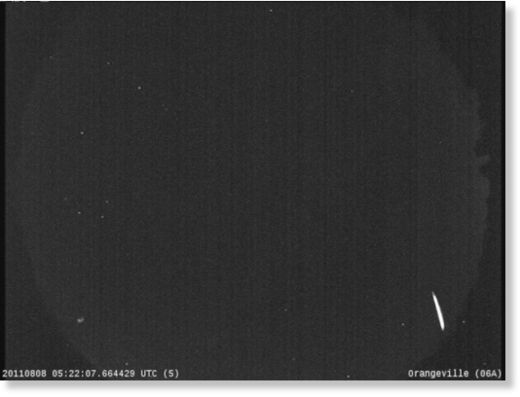
© Southern Ontario Meteor Network
On
August 8 at 1:22 Eastern Daylight Time, 4 all sky cameras belonging to
the Southern Ontario Meteor Network detected a fireball entering the
atmosphere 54 miles above Lake Erie (80.944 W, 41.945 N), moving SSE at
25 km/s (55,900 mph).
On
August 8 at 1:22 Eastern Daylight Time, 4 all sky cameras belonging to
the Southern Ontario Meteor Network detected a fireball entering the
atmosphere 54 miles above Lake Erie (80.944 W, 41.945 N), moving SSE at
25 km/s (55,900 mph).
Ohio residents should be on the
lookout for potential small meteorites that may have been created by a
bright fireball that streaked over southern Ontario, Canada, last week,
NASA says.
The fireball was detected by all-sky cameras from the Southern Ontario Meteor Network at 1:22 a.m. EDT (0522 GMT) on Aug. 8.
"It was picked up over Lake Erie and proceeded south-southeast over
Ohio," said Bill Cooke, head of NASA's Meteoroid Environments Office at
the Marshall Space Flight Center in Huntsville, Ala. [Video: See the Aug. 8 fireball]
The meteor was last tracked north of Gustavus, Ohio, and the potential impact zone for meteorite fragments is a region east of Cleveland, Cooke told SPACE.com.
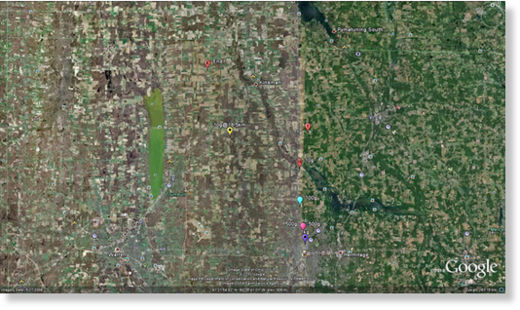
©
Google; Image State of Ohio/OSIP; Image PA Department of Conservation
and Natural Resources-PAMAP/USGS; Image USDA Farm Service Agency
This
map shows the calculated darkflight impact points for the meteor
spotted over Lake Erie on On August 8, 2011, at 1:22 Eastern Daylight
Time.
Google; Image State of Ohio/OSIP; Image PA Department of Conservation
and Natural Resources-PAMAP/USGS; Image USDA Farm Service Agency
This
map shows the calculated darkflight impact points for the meteor
spotted over Lake Erie on On August 8, 2011, at 1:22 Eastern Daylight
Time.
When would-be meteors are traveling through
space, they are known as meteoroids to astronomers. When they enter
Earth's atmosphere to create fireballs, they are called meteors. Only
fragments that actually reach Earth's surface are called meteorites.
"We look for ones that are moving low and slow, ones that penetrate deep
into the atmosphere," Cooke said. "Normally meteors burn up 40 to 50
miles (about 65 to 80 kilometers) over your head. This one got down to
38 km (24 miles) before we lost track of it, and we know it went lower."
When a meteor penetrates low into the atmosphere and moves relatively
slow, it can create meteorites that fall to the ground, Cooke explained.
The fireball seen last week slowed to approximately 25,200 mph (40,555
kph). [Photos: Amazing Perseid Meteor Shower Displays]
And while skywatchers around the world enjoyed spectacular views of the
annual Perseid meteor shower last week, Cooke clarified that this
fireball is definitely not a Perseid because it is moving too slowly.
Based on the fireball's brightness
and radar observations, the meteor's mass is estimated to be in the
range of 22 pounds (10 kilograms). This means that meteorite fragments
will likely be pretty small, Cooke said.
"Something the size of your thumbnail, maybe a bit bigger," he said,
estimating that any rocks found would probably be about three ounces
(roughly 100 grams) and measure about one to two inches (2.5 to 5 cm)
across.
For meteorite hunters in the area, or for anyone who fortuitously
stumbles across any pieces of space rock, Cooke wants to know about it,
and people are encouraged to contact NASA's Meteoroid Environments Office if they find any fragments.
But, the meteorite expert cautions that there are strict rules governing the ownership of space rocks that fall from the sky.
"One thing you need to know is that meteorites belong to the property
holder, the owner of the property on which they land," he said. "So, if
you're looking for them on someone's property, be sure you talk to them
and get their permission first. If you're looking for meteorites,
respect the wishes and rights of all property owners."
You can follow SPACE.com staff writer Denise Chow on Twitter
@denisechow. Follow SPACE.com for the latest in space science and
exploration news on Twitter @Spacedotcom and on Facebook.
Scientists plan to smash a spacecraft into an asteroid so that they are prepared for having to stop one hurtling towards Earth.
The news came as Nasa moved to calm fears that a comet is on a collision course with our planet.
The plans for a test mission to stop an asteroid from colliding with Earth come from Nasa's cousin, the European Space Agency.
In the Hollywood movie Armageddon, Bruce Willis attempts to blow up a huge asteroid hurtling towards Earth.
In real life, the mission, called Don Quixote, will see two spacecraft launched.
One will be fired at an asteroid at break-neck speed in an
attempt to push it off its course. The other will analyse data with the
aim of informing future missions in which the future of mankind may be
at stake.
One potential target for the test mission is a 1,600ft-wide asteroid
called 99942 Apophis, which has a tiny chance - around one in 250,000
- of hitting Earth in 2036.
Nasa scientists yesterday took the unusual step of officially dismissing
claims sweeping the internet that comet Elenin, discovered by an
astronomer last December, is on a deadly course.
Comment: This is a red herring. Elenin was never in
danger of colliding with Earth. The danger lies in something NASA
claims to have no awareness of - that comets 'impact' our celestial
environment by causing the Sun to discharge enormous amounts of energy
from afar.
Scare stories include the comet plunging the Earth into darkness for
three days by blocking out the sun, colliding with Earth, moving tides
or continents and throwing the planet off orbit.
It is even claimed that a fleet of UFOs are streaking towards us in the
comet's wake, and that Nasa has conspired with media organisations to
create a news blackout on the comet to avoid mass panic sweeping the
world.
Comment: Richard Hoagland's disinformation has clearly served NASA well.
But the space agency said Elenin will never come closer to Earth
than 22 million miles and will not compromise our planet in any way.
An official said: 'The truth is that Elenin has received much more
attention than it deserves due to a variety of internet postings that
are untrue.'
Comment: So on the one hand NASA publicises
plans to blow up space rocks that may or may not be on a collision
course with Earth, while on the other hand this US government agency
ridicules the most outlandish claims about Comet Elenin. This 'speaking
out of both sides of the mouth' is intended to reassure those waking up
to the fact that Something Wicked This Way Comes
that they have everything under control. They don't, of course. At
most, they are planning their own escape while leaving us in the dark.
Residents of northeastern Ohio and western Pennsylvania should be on the lookout for space rocks.
At 1:22 a.m. Aug. 8, sky cameras belonging to the Southern Ontario
Meteor Network in Canada recorded a meteor as it entered the Earth's
atmosphere over Lake Erie, and scientists at NASA say they have "high
confidence" that pieces of the meteor landed in northern Trumbull
County.
The "fireball" entered the atmosphere 54 miles above Lake Erie,
traveling south-by-southeast at approximately 55,900 mph. Dr. William
Cooke, head of NASA's Meteoroid Environment Office, said debris created
Doppler radar echoes west of Hermitage, Pa.
The International Astronomical Union defines a fireball as "a meteorite
brighter than any of the planets." In essence, the mass and speed of the
meteor increase its visibility, Cooke said.
Cooke said the fragments are about two to three inches in diameter and likely weigh a few ounces.
Patrick Durrell, an astronomy professor at Youngstown State University
said the fragments can be difficult to identify, but there is at least
one telltale sign.
"If you pick up a rock that feels a lot heavier than you'd expect for its size, that's a good place to start," Durrell said.
Durrell and Cooke both said meteorite landings like this one are highly common and occur daily.
Jay Reynolds, research astronomer at Cleveland State
University, said meteorites like this one are not dangerous, and have no
radioactivity but are scientifically "very fascinating when you can
find them."
Reynolds said denser meteorites are usually the ones that make contact
with the Earth because they can withstand the pressure of the thicker
layers of Earth's atmosphere.
He said in this case, the thicker layers caused the meteor to fracture into meteorites.
"While you won't see something like this coming into this area every
night, in and of itself, it's not that uncommon," Durrell said.
Cooke said that while meteorite falls are very common, a given point on
Earth may only see such a fireball once every couple of decades.
What makes this sighting special, Cooke said, is that the meteor was tracked and its trajectory recorded from start to finish.
"Very few meteorites are tracked on their way down, so this would be very special," Cooke said.
Reynolds said many of the meteorites that have been found over time are
composed largely of iron and small amounts of nickel and other metal
compounds, with carbonaceous cores.
Cooke, however, said the composition of this meteor is unknown and will not be determined until a fragment is found and studied.
He said the farthest point of the meteor's orbit corresponds with the
outer edge of the asteroid belt between the planets of Mars and Jupiter.
Should the National Aeronautics and Space Administration retrieve a
piece of this meteor, Cooke said, they could determine the compositional
differences of matter based on distance from the sun.
Of course, that kind of research hinges entirely upon somebody actually
finding a piece of meteorite, and so far, Cooke said, nobody has
reported one.
Residents contacted in Kinsman and Gustavus reported no knowledge of finding any space rock.
"Nobody mentioned it at lunch today. It's news to me," said Kinsman
Township Trustee Tony Gates, who dines regularly with residents of
Kinsman and Gustavus.
Gustavus Trustee Alan Bradford echoed Gates: "I haven't heard anybody say anything about it."
Astronomers and other outer space experts are speaking out on a comet
expected to make a close call with colliding into Earth later this
year. The consequences could be dire, so why are so many people unaware
of it?
"I think it's worth a raised eyebrow" says author Brooks Agnew. He's
done a lot of research on Elenin and tells RT that there are some rather
strange coincidences regarding the comet that people should take into
consideration.
"A lot of people are concerned about it," says Agnew. "We've done a lot
of research on Comet Elenin and what we've found is there's a lot of
missing data on this comet"
Agnew says that NASA calls the comet just "a harmless little fuzzball of
ice" that won't come within more than 20 million miles from Earth.
Others, he says, are claiming that this comet should raise concern since
it doesn't look like a comet, doesn't act like a comet and is coming
from outside of the area where most comets are accustomed to originate
out of.
"There are a lot of things about this comet that don't make sense," Agnew says.
Another thing raising concern for the author is that another
large asteroid is expected to come close to Earth around the same time.
Coincidentally, he says, a new emergency alert system has been announced
to debut the same day that asteroid will rock right by our planet.
Agnew attests that allegations about the impact of Elenin have been
discussed for centuries, and says that people shouldn't just shrug them
off as crackpot theories. "We've been put off by professionals saying
everything is going to be fine, but those of us that have been watching
the cosmological signs, geological signs [and] oceanographic signs have
been showing that there is the trend that the ancients said would be
happening."
"What we should be aware of is that the projections [are] highly
estimated. There are a lot of forces working on this comet as it travels
through our solar system from a very off angle and not all of them have
been calculated. So were kind of making a guess of where this thing is
going to end up - and a guess might not be good enough."
If projections aren't enough proof, Agnew says to look no further than
the major governments of the world. Both the US and Russia have invested
fortunes into new underground shelters, and the author says there has
to be a reason for it. NASA, he says, has also recently circulated a
video among the families of employees advising them what to do in case
of an upcoming emergency.
According to Agnew, it's time to connect the dots, and he's not just talking about constellations.
Comment: There has been much disinformation and
plain hysteria around the topic of Comet Elenin that contribute to the
general confusion regarding possible effects of the comet on Earth and
our civilization.
We advise our readers to take a look at the following articles that bring sanity to this highly charged topic.
Elenin, Nibiru, Planet-X - Time for a Sanity Check
Cosmic Propaganda Alert! Comet Elenin: Just Passing By - With SOTT Commentary
Interview with Russian astronomer Leonid Elenin - The discoverer of Comet Elenin
Chinese researchers from Beijing's Tsinghua University have revealed
plans to divert the asteroid Apophis - which may well collide with
Earth in a couple decades - by smashing a kamikaze solar sail into it.
The asteroid, 99942 Apophis
to give it its full title, is a 46 million tonne, 1,600-foot-wide chunk
of space rock that's currently hurtling its way towards our planet. In
2029 it will soar safely past Earth, but we won't be out of the woods
just yet.
There's a possibility that it will pass through a slim gravitational
keyhole - a tiny, 600 mile area of space - that would cause the
asteroid to turn back on itself and strike Earth some seven years later
in 2036.
Read the full article on Wired.com.
NASA scientists have analyzed the photograph taken by Ron Garan
aboard the ISS during the 2011 Perseid Meteor Shower and have deduced
the size and speed it was traveling at when it hit the Earth's
atmosphere.
Scotland: Unidentified Falling Object Seen Over Loch Ness
Scottish police are scratching their heads over a mysterious occurrence at Loch Ness this weekend, The Scotsman newspaper reports.
On Saturday night several eyewitnesses saw an object falling into or
near the loch. Some describe it as a white light, others as a blue
light. People said it was a balloon, or an ultralight, or a parachute.
Some people said it didn't fall at all, merely passed over the tree
line.
In other words, nobody has the faintest idea what they saw.
So many people called emergency services, however, that it's certain
something strange was going on in the skies, and the police, the
coastguard, a lifeboat crew, and the Royal Air Force went in search of
it. Several hours of looking in the water and along the shore turned up
nothing.
So what was it? Possibly a meteor. Meteors often cause UFO
flaps. Large ones called "fireballs" or "bolides" can light up the sky
and even change color as their various minerals get ionized from the
heat of entering our atmosphere. Since they streak across the night sky
so quickly, it's hard to judge distance or location. This photo,
courtesy of Wikimedia Commons, shows a bolide. It's not a photo of whatever was over Loch Ness.
Sadly, there were no reported sightings of Nessie this weekend. Some people say the poor Loch Ness Monster may be extinct.
Meteorites Possible From Irish Fireball
Astronomy
Ireland (AI) has confirmed that a fireball meteor entered the
atmosphere above Ireland in the early hours of Tuesday morning (23
August 2011).
The organisation added that meteor fragments are likely to have reached
the surface but it remains unclear at this stage if the impact occurred
overland or in the Atlantic Ocean.
Astronomy Ireland says it has already received dozens of reports of a
bright fireball shooting across Irish skies at approximately 12:15 AM on
Tuesday. 60-70% of reports received came from the Greater Dublin area
with other reports being received from Tipperary, Meath, Cork, Mayo and
Kerry.
Initial reports suggest the fireball moved westward in a line from north
Dublin to south Mayo, meaning anyone living to the north of this line
would have observed the fireball to the south and vice versa for those
living south of the Midlands.
Only two meteorites have been successfully retrieved on the
island of Ireland since the beginning of the 20th century. A meteorite
was recovered in Northern Ireland in 1969, while in November 1999 a
meteorite fall in County Carlow earned a local woman almost €15,000 when
she recovered four egg-sized pieces. Fragments were subsequently
donated to the National History Museum in London and Trinity College
Dublin.
According to AI's Conor Farrell: "There is high confidence that this
meteor produced meteorites. If the fireball was brighter than the Full
Moon, as has been reported by many people today, then it is well worth
looking for a meteorite (the part that survives the fall to Earth).
However, it remains unclear whether they impacted overland or in the
sea. Even if the main body of the meteorite crashed into the sea,
smaller pieces could have fallen earlier on land", explained.
He added: "We would appeal to anyone who may have captured the fireball
on video or camera to visit our website as soon as possible. We would
also ask anyone who operates a CCTV system to review video from around
12:15am this morning."
Mr. Farrell said that average meteor is no bigger than a grain of sand.
He continued: "When it collides with the Earth the closing speed can be
of the order of 100,000mph and the friction with the thin air 100 miles
above the ground quickly heats the tiny particle until it vapourises in a
fiery streak which we call a shooting star and that typically only
lasts one second or so."
"Most meteors are caused by small particles of dust that were left
behind by comets. The brighter meteors come from larger particles.
Fireballs are probably caused by objects the size of a pea, and larger.
Comets leave very few large particles behind them so most fireballs
probably come from pieces smashed off asteroids as the result of
something (probably another asteroid) colliding with an asteroid,
probably millions of years ago. Most asteroids orbit the Sun between the
orbits of Mars and Jupiter i.e. between 2 and 4 times the Earth's
distance from the Sun. Compared to planets, most asteroids are small
(only a handful are bigger than 100 miles across) but they are rocky and
some have metal cores", he concluded.
To report a Fireball or submit images/video visit the Astronomy Ireland website.
Notable European Meteorite Finds
The Cape York meteorite was found in Savissivik, Greenland, and is one of the world's largest iron meteorites.
Elbogen - The oldest recorded meteorite in the Czech Republic, also known as the "betwitched burgrave".
Hrascina meteorite - Croatian meteorite first speculated as originating from outer space.
Orgueil is a scientifically important carbonaceous chondrite meteorite that fell in SW France in 1864.
A number of southern Manitoba residents noticed something unique in
the sky last night. Scott Young is an astronomer at The Manitoba Museum,
and shares they've already received quite a few reports.
Young tells us people were able to watch it for a few seconds, and it
was one of those once in a lifetime kind of experiences. If you did
witness it he says consider yourself one of the lucky ones. Young
explains they are currently collecting as many as reports as possible,
and have activated their meteorite search team. He adds even if they
narrow it down they'll be covering a lot of ground and that takes a lot
of people. Anyone interested in volunteering in the search can contact
the museum.
He shares only 13 actual meteorites have ever been found in Manitoba
even though people bring potential meteorites to the museum once a week,
and have for 40 years. Young tells us they receive calls daily about
events or sightings in the night sky.
A strange object spotted by residents in the skies above Birżebbuġa
on Saturday night could have been a "very bright meteor", also referred
to as a fireball, according to the Astronomical Society of Malta.
It has attempted to shed light on the outlandish sighting, described by
curious resident Charles Caruana as resembling a "hot air balloon"
because it was clearly on fire.
Mr Caruana, who filmed the sight, said it advanced at speed from Żurrieq
and over the water polo pitch towards the Freeport until it disappeared
in the distance within minutes.
It was about 9 p.m. when he caught sight of it and zoomed off to get
hold of his camera, saying it was the size of a car and was neither too
high nor too far.
Mr Caruana excluded that it was a flying saucer because it was alight,
but was still curious to know what it was. His curiosity was not
satisfied when he went to buy the newspapers the next day.
Perhaps the most "extraordinary" observation, in Mr Caruana's
view, was that it was not simply rising through the air but "zipping"
and "dancing" at speed. Had it merely been an object that caught fire,
rising slowly into the sky, Mr Caruana, who does not have particular
extraterrestrial interests, would not have thought much of it. However,
as it were, the unusual sight was more suspicious than pleasant.
The fire could be deciphered from when it was spotted over Żurrieq, but
the possibility that it was a plane ablaze was quickly ruled out.
Although the only image the society had at its disposition to determine
the nature of the object was out of focus, its president, Alexei Pace,
said it could be deduced from the description that it was a fireball.
Meteors were caused when specks of rocks from outer space entered the
earth's atmosphere at high speed and burned up to produce the streak of
light that was called a shooting star, Mr Pace explained.
The recent Perseid meteor shower, the famous Tears of St Lawrence, peaked on the night of August 12, he pointed out.
"Fireballs are caused when a larger object enters the atmosphere and
burns up spectacularly. It often takes several seconds to disintegrate
and, often, it does not burn up entirely because it is too big, ending
up on the surface of the earth as a meteorite," Mr Pace explained. "In
this case, it seems this did not happen. It appears the rock from outer
space simply burned up in the atmosphere."
Avid observers of the night sky, the members of the society have
witnessed several of these fireballs and "each one remains vivid in our
memories". Sometimes, they change colour as their various components
burn up separately. On other occasions, they can break up during entry,
or even explode at the end.
Mr Pace was "fairly confident" something similar had been observed by Mr
Caruana. His only scepticism lay in comments on its size or that it
zipped through the sky. He said these were subjective and did not really
tally with a scientific explanation.
Did you see something unusual streaking across the sky Tuesday night? You're not alone.
Echo Press reader Brian Alvstad posted this on the newspaper's
Facebook page Wednesday: "Find out what the heck that meteor or asteroid
or comet was that flew in the sky around 9:45 last night [Tuesday]...it
was green and purple and you could tell when it broke through the
atmosphere. Pretty much the coolest thing ever."
After hunting around on the Internet, the newspaper found a blog - lunarmeteoritehunters.blogspot - that included several sightings of a fireball or meteor from sky watchers across the Midwest on Tuesday night.
Here are just a few:
Huron, South Dakota: "At approximately
9:40 we saw a large fireball fall from the sky northwest of Huron. It
lasted approximately five to seven seconds. Bright ball of fire with
blue green tail."
Delano, Minnesota: "Tonight along Highway
12 heading west approaching Delano, I witnessed an orange fireball
hurling towards the ground at a slant from the north at approximately
9:33 p.m. It hit ground in a corn field but was unable to see where
exactly it landed."
Grand Forks, North Dakota: "Saw a bright
green fireball in the south-southwest sky between 9:30 and 9:35 p.m.
Description: Green ball of light...slightly above in brightness moving
to the southeast."
Bismarck North Dakota: "Approximately
9:40, was driving and something flashed in the sky, looked up, and there
was a VERY bright streak across the sky, mildly slow moving for a
meteorite. It lit up the entire sky and land, and both me and my
girlfriend were amazed by it...Very beautiful event, lasted a few
seconds, colorful, and very bright - almost had a strobe like effect."
Shafer, Minnesota: "My Husband, daughter
and I were driving westward on U.S. Highway 8 about one mile east of
Shafer (near the Wisconsin border) at 9:38 p.m. We all saw a green/blue
fireball with a short white tail about 45 degrees high in the sky, about
1:00 direction from our vehicle as we were heading due west. It was so
large at first I thought it was a dud firework falling to the ground but
I quickly realized it must have been a meteorite. It came down in an
upper left toward the lower right trajectory, northward. I was driving
so I had to watch the road, but my husband and daughter thought they saw
a yellowish flash in the horizon behind the tree line/town, but we are
unsure how far away it was. It was pretty amazing!"
Oakwood State Park, South Dakota: "We saw a
huge fireball fall from the sky in the west. It was dark in the center
surrounded by blue and orange. It lit up the sky and lasted about five
to seven seconds."
Collegeville, Minnesota: "Around 9:30
p.m., I was coming home from St. Cloud and was near St. John's
University or city of Collegeville and saw a bright green light fall
from the sky and it went through the trees and appeared to hit the
earth. Once it landed, there was like a shockwave of light, like
lightning coming from the ground and spread out for a instant then went
dark."
Arvilla, North Dakota: "On Tuesday, at
about 9:40 p.m., I witnessed a bright green ball of light headed west
just south of Arvilla. Easily as bright as the moon."
Saskatchewan, Canada: "At approximately
9:30 p.m. last night (Tuesday), I was heading south towards the town of
Maryfield, Saskatchewan and saw a BRIGHT blue ball of fire with a long
tail that lit up the sky that lasted for at least five seconds. Then
before it hit the ground there was a large flash of white light like an
explosion and it was gone."
Detroit Lakes, Minnesota: "Last night
(Tuesday), I saw a blue light followed by a bright white light when it
hit the ground...This was about 9:30 p.m. It was viewed to the southwest
in the sky."
Beulah, North Dakota: "Several people,
family and friends, reported to me they saw a blue flash of light while
outdoors last night. It happened between 9:30 and 10 p.m. The sky was
clear and sun was almost set. They described it as a blue flash of light
that lit up the darkening outdoors as a stroke of lightning would."
Al Edenloff is a reporter at the Alexandria (Minn.) Echo Press, which is owned by Forum Communications Co.
Blazing with the fury of a mini-sun this amazing video shows the
moment a suspected meteor streaked across the sky over the city of Cusco
in Peru.
It was captured blasting through the upper levels of the atmosphere at
2pm yesterday afternoon, leaving an iridescent trail in its wake.
Astonished residents watched as the impressive natural phenomena eventually disappeared over the horizon.
Experts believe it may have caused forest fires in the south of the city, which have been ravaged by drought.
Local officials and the National Police are currently trying to
determine where the meteorite may have landed and are speaking to
farmers south of the city.
The meteorite fell in the south of the Imperial City, between the districts of San Sebastian and San Geronimo.
Cusco is the gateway to the Inca citadel of Machu Picchu. The Inca trail
attracts tens of thousands of tourists every year, with entry
restricted to 200 new travelers each day.
Peru last saw a meteorite fall in September 2007 near the border with Bolivia.

© Unknown
Blazing fury: The meteorite was broadcast on local TV just hours after it flew across Cusco in Peru yesterday
Blazing fury: The meteorite was broadcast on local TV just hours after it flew across Cusco in Peru yesterday
The
basketball-sized meteorite left an impressive crater that was 44ft in
diameter. Fragments of rock tested positive for iron, nickel and cobalt
with traces of iridium.
It was dated as about 4.5 billion years old and formed around the same time as our Solar System.
Meteorites are fragments of rock and sometimes metal that survive the
fall to Earth from space. Most are fragments left over from the
collision of two asteroids.
Captured by Earth's gravitational force, they are accelerated to speeds of over 11.2 kilometres per second.
They can vary in size from a fraction of a millimetre to larger than a
football pitch. It is believed a meteorite six miles across wiped out
the dinosaurs 65million years ago.
Hundreds of meteorites fall to Earth each year but only a handful are recovered.

© Unknown
The meteorite was spotted in the Andean city of Cusco, home of the Inca citadel Machu Picchu
He
spends most of his day at office and commuting to and from Mumbai in
crowded suburban trains but accountant Shishir Deshmukh still finds time
to look at the stars and pursue his passion for astronomy. And he has just discovered his sixth comet in just nine months, the first by an Indian.
His latest discovery was a Kreutz Group comet Thursday evening.
"I feel very thrilled by my discoveries, the first by an Indian. It
gives great pleasure. Although I am an amateur astronomer, I have made a
small contribution to the world of astronomy," an excited Deshmukh, who
works as an assistant accounts manager with a leading realty group,
told IANS.
The Kreutz Group of comets is named after a German astronomer, Heinrich
Kreutz, who discovered that these types of comets - which travel around
the sun and consist of a solid frozen nucleus part and a long luminous
tail - have their orbits very close to the sun.
"These comets are generally very fragile, barely a few metres long and
keep disintegrating throughout their orbit," explained Deshmukh, a
commerce graduate from the University of Mumbai with an M.Phil in
information science.
These comets are much smaller than the better known large comets like Halley's Comet.
"But they (the small ones) are very useful to the study of the dynamics
of orbits of comets, their disintegration process and perturbations from
giant planets," he added.
"Actually, what we are seeing now in the form of Kreutz Comets
is the debris or left-overs of very large comets which come in the
vicinity of our solar system once in a few centuries.
"From the orbits of some of the Kreutz Comets, it is estimated that one
such huge comet was seen in 1106, then in 1882 and last in 1965,"
Deshmukh, 37, explained.
Besides, some short period comets are also observed using Solar &
Heliospheric Observatory (SOHO) data, which help scientists understand
their orbital dynamics and rate of erosion each time they visit our
solar vicinity.
On the basis of their observations, astronomers can estimate their
expected time of return - and the possible risks to mankind, he said.
Detailing his achievement, Deshmukh said it involves a furiously
competitive study of images of the sun sent by SOHO, which is a space
observatory between the sun and earth, some 1.5 million km away from our
planet.
"It beams one image every 12 minutes which is uploaded on its official
website 24x7 and picked up by astronomers worldwide. I also studied
them, measured the positions of any suspicious objects, picked out my
claims and submitted them for confirmation, including the one yesterday
(Thursday)," he said.
"My latest discovery - yesterday evening - has also been acknowledged as
genuine and the official confirmation is expected soon," Deshmukh said.
The plaudits have been many.
Deshmukh was felicitated for his achievement by former president A.P.J. Abdul Kalam in Dombivali last March.
In January this year, Deshmukh, co-author of a book, Astronomy of Eclipses,
was commended and felicitated by eminent nuclear scientist Anil
Kakodkar for becoming the first Indian amateur astronomer to get
international recognition as a discoverer of SOHO comet.
He will speak on "Comet Hunting With SOHO" at a major felicitation
organised by the Bombay Amateur Astronomers Association Saturday.
In the past 15 years or so, a total of 2,122 Kreutz Group of comets have
been discovered by professional and amateur astronomers worldwide.
German astronomer Rainer Kracht holds a tally of 225 discoveries.
Other astronomers have made smaller individual discoveries, including Deshmukh, of course.
Prior to Deshmukh, late Indian astronomer M.K.V. Bappu of Andhra Pradesh
along with two international scientists, discovered a conventional
comet which was later named after them as 'Bappu-Bok-Newkirk Comet' in
1949.
On the night of August 20th, numerous people and pilots in both
Beijing and Shanghai reported seeing a strange ball of light that grew
bigger and bigger over the cities' skies. The topic has been creating
quite a lot of buzz among Chinese netizens, with many claiming that the
strange glow was actually a "Super UFO". Several pilots who were mid-air
at the time reported seeing a huge white ball flying at an altitude of
10.7km, one that appeared several hundred times larger than the moon.
The mysterious phenomenon was visible for 20 minutes and was reported to
the East China Air Traffic Control Bureau. As usual, no official
explanation for this mysterious sighting has been given.
Comet Double Feature: Comets Elenin & Garradd Now Showing in Night Sky
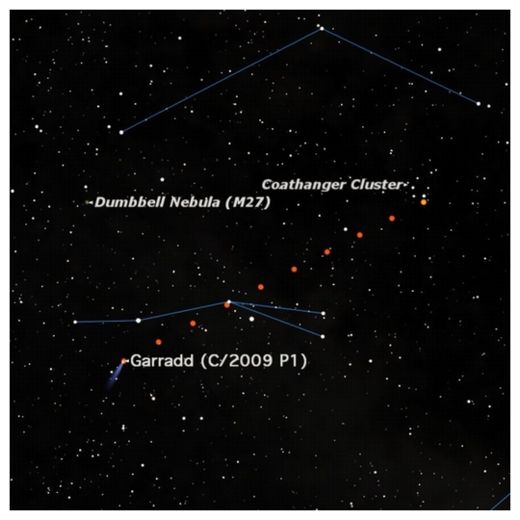
Skywatchers often ask "When's the next comet?" In fact, if you're
prepared to do a bit of searching, there are always several comets
visible in the night sky, including two right now.
Some comets are like old friends, they keep coming back at regular intervals to visit. These are called periodic comets; Comet Halley was the first
such comet to be identified, by Edmond Halley back in 1705. It returns
to the inner solar system every 75 to 76 years; its last appearance was
in 1986 and its next will be in 2061. At present Halley is out just
beyond Neptune's orbit.
Other comets are one-time visitors: they come in to visit us from the
Oort Cloud, warm themselves for a few months by the sun, and then head
back out to the farthest reaches of the solar system.
There are two comets currently visiting the inner solar system - comet
Elenin and comet Garradd - so the next two months will provide some
excellent opportunities to observe these unusual visitors. The sky map of the two comets here shows their locations over the next few weeks.
All comets share one characteristic: they are like "dirty
snowballs" in their makeup. Their nucleus of rock and ice, when warmed
by the sun, sheds its ice which forms a graceful tail as it's swept away
by the solar wind. Because it's the solar wind that drives the gas and
vapor away, comet's tails always point away from the sun.
Comment: If comets were actually "dirty snowballs"
like this author claims, then why have all attempts to disturb the
surface of comets produced nothing but rock and dust?
Oh, I know what you're thinking, the water and ice must be trapped on
the inside and only "leaks out" to form the long comet tail, right?
Wrong. In fact, comet tails appear to be an entirely electric
phenomenon (why else would they only point in the direction of the solar
wind, for instance?) and the H20 observed within the tail is likely due to chemical processes brought on by powerful electric currents. As stated in our summary of James McCanney's theories on comets:
But in case you need more proof, this little video
should suffice to sum up the main points of why comets cannot possibly
be "dirty snowballs" as many mainstream astronomers have painted them to
be.
In the sky, many comets appear like ghostly fingers pointing down
towards Earth. That is one reason why comets have traditionally been
viewed as harbingers of death and disaster. To astronomers, on the
contrary, they are objects of great beauty and attract close scientific
scrutiny for the information they reveal about the ancient history of
the solar system and its farthest reaches.
Comet Elenin now showing
The first comet visitor in the sky we'll review is comet Elenin (C2010
X1). You may have heard about, because it's become a popular item for
the gloom and doom crowd, who see portents of disaster in ordinary
astronomical objects.
The truth about Comet Elenin
is that it is a quite ordinary, fairly small comet discovered on Dec.
10, 2010 by Russian amateur astronomer Leonid Elenin using a remote
controlled telescope in Arizona.
This comet will pass closest to the sun on Sept. 10 (45 million miles or
72 million kilometers) and closest to Earth on Oct. 16 at a distance of
22 million miles (35 million km.)
Despite the fact that this is a really tiny body, 3 or 4 km. in diameter which will miss the Earth by 22 million miles, the purveyors of gloom and doom
have seized upon it as bringing disaster upon the Earth. Please don't
take them seriously, instead try to spot this interesting little object.
Comment: The "purveyors of gloom and doom" have
certainly latched onto the buzz surrounding Comet Elenin, but we suspect
the situation is not so cut and dry:
Elenin, Nibiru, Planet-X - Time for a Sanity Check
At present, comet Elenin is too close to the sun to be viewed from
the Northern Hemisphere, though observers south of the equator may catch
it low in the western sky after sunset. Northern observers' turn will
come after the comet passes the sun and starts back out towards the Oort
Cloud.
In the last few days of September, Elenin will separate from the sun in
our morning sky. It will be visible in binoculars in the morning sky for
all of October, and we will publish finder maps then.
There is an unusual opportunity to "observe" this comet when it is very
close to the sun during the last week of September. To do this, you
won't be able to use your eyes or any optical aid; instead you will use
your computer.
Several times every day, the SOHO satellite returns images of the sun, including ones from the observatory's LASCO C3 camera
which has a field of view of about 15 degrees. This has an occulting
disk which blocks the Sun itself but lets the background stars appear.
If you take a look at it right now, you'll see Venus off to the left of
the sun and the star Regulus to the right. During the last week of
September, you will be able to see Comet Elenin pass through the field
of view.
Comet Garradd graces the sky
The other bright comet in the night sky hasn't received the publicity of
comet Elenin but is actually a better opportunity for skywatchers. This
is comet Garradd (C2009 P1), which was discovered on Aug. 13, 2009 by
Australian astronomer G. J. Garradd.
Comet Garradd is very easy for any experienced skywatcher to locate and
observe with binoculars. Currently it is just south of the small but
well-known constellation of Sagitta, the arrow. This arrow-shaped
constellation is right in the middle of the summer triangle formed by
the bright stars Vega, Deneb, and Altair. On Wednesday (Aug. 24),
Garradd was right under the tip of the arrow.
Tonight (Friday, Aug. 26), Garradd it will be impaled by the shaft of
the arrow, and one week later (Friday, Sept. 2) it will be right by the
"hook" of the popular Coathanger Cluster, also known as Brocchi's
Cluster. During that time it should increase in brightness from about
magnitude 8.2 to about magnitude 6.9, an easy object with binoculars.
The comet will continue moving westward and brightening until it reaches
magnitude 5.8 on September 16. Then it will begin to fade.
The sky map in this story shows the position of comet Garradd at 11 p.m. EDT each night from through Sept 2.
A reminder: All of the magnitudes given here for comets are estimates;
comet brightness is notoriously hard to predict. The comets may be
fainter than predicted or we may get lucky and get a couple of really
bright comets.
Editor's note: If you snap an amazing photo of Comet Elenin or Comet
Garradd, and would like to share them with SPACE.com for a possible
story or gallery, please contact managing editor Tariq Malik at:
tmalik@space.com.
Over the weekend, incoming Comet Garradd passed beautifully close to globular star cluster M71.
For all those amateur astronomers caught under hurricane clouds, John
Chumack of Dayton, Ohio, recorded the encounter in the form of a 2.5
hour time-lapse movie:
"It was so cool watching the comet's tail cross the cluster," says Chumack. "I had a great view through my home-made 16-inch telescope."
At the moment, Comet Garradd can only be seen through a backyard telescope (recommended: The Comet Hunter).
It is, however, approaching the sun and brightening. Recent projections
place it at peak magnitude 6, on the threshold of naked-eye visibility,
in February 2012. Because Comet Garradd is a first-time visitor to the
inner solar system, it could behave in unexpected ways, perhaps
exceeding those expectations. Stay tuned--and meanwhile browse the image
links below.
More Images
From Daniele Cipollina of Arquata Scrivia, Alessandria, Italy; from Nick Howes of Cherhill in Wiltshire UK; from Ulf Petersson of Öland, Sweden; from Doug Zubenel of Linn Co., Kansas; from Marek Harman of Vartovka observatory, Banská Bystrica, Slovakia; from Karl Beck of Observatory Michelbach, Austria; from Jimmy Westlake of Stagecoach, Colorado; from Marian Urbaník of Čadca, Slovak republic; from Becky Ramotowski of Tijeras, New Mexico.
Comet Links:
Finder charts, 3D orbit.
A strange light filmed in the sky over Auckland on Saturday night was
probably not a UFO, comet, or rogue planet about to smash into Earth,
astronomers say.
The descending point of light, which revealed a U-shaped nimbus when
zoomed in on, was filmed in the sky west of Auckland about 6pm on
Saturday.
The video was uploaded to YouTube by a user known as biggordy100 who
narrates that the light is "back", indicating he has seen it in the
past.
The tag-line on the video reads: "WTF is in our skies? ufo! nibiru? elenin? spaceship? comet? seen over Auckland at 18.00."
Nibiru is the name given by Doomsday and conspiracy blogs and websites
to a supposed collision between Earth and a mystery planet - Planet X -
that is supposed to occur in the early 21st Century.
According to Wikipedia, Nibiru was revealed to Wisconsin woman
Nancy Lieder after aliens implanted a communications device in her
brain.
Comet Elenin has a similar conspiracy theory attached to it - something
about it actually being a secret brown dwarf star that is going to flip
the Earth's magnetic polarity with disastrous results.
Astronomers who could be bothered have debunked both theories.
Astronomy educator at Auckland's Stardome Observatory, David Britten,
said Nibiru would not hit Earth "because it doesn't exist".
He said the light that had been filmed was "almost certainly the contrails of a plane heading out over the Tasman Sea".
Britten said at that time, the sun had set enough for Auckland to be in shadow but the plane was still in the sun.
Its spreading contrail was catching the light and making the effect recorded.
Britten said the observatory was approached about similar sights semi-regularly.
"Look at the coverage over Hurricane Irene - if there was something out
there that was going to hurt us, we would know about it.''
He said if the videographer had waited for dark, with a telescope he
might have seen Saturn and its rings in approximately the same spot.
Comment: This article is a good example of how
unsubstantiated theories based on lies and ignorance lead to even more
ignorance, ridicule and faulty science. It's true that Nibiru and Comet
Elenin hysteria is blown way out of proportions, but the following
statement "if there was something out there that was going to hurt us,
we would know about it" clearly demonstrates astronomers' lack of
knowledge when it comes to threats from space or PTB's effort to conceal
them.
Read the following articles to learn more on the topic:
The Hazard to Civilization from Fireballs and Comets
Forget About Global Warming: We're One Step From Extinction!
Elenin, Nibiru, Planet-X - Time for a Sanity Check
Cosmic Propaganda Alert! Comet Elenin: Just Passing By - With SOTT Commentary
Comet Elenin Could Be Disintegrating
Astronomers
monitoring Comet Elenin have noticed the comet has decreased in
brightness the past week, and the coma is now elongating and diffusing.
Some astronomers predict the comet will disintegrate and not survive
perihelion, its closest approach to the Sun.
On August 19, a massive solar flare and coronal mass ejection hit the
comet, which may have been the beginning of the end for the much
ballyhooed lump of ice and dirt.
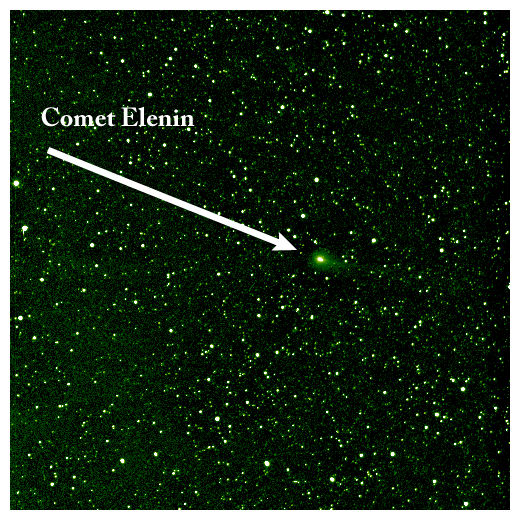
We've
been following it in the STEREO spacecraft images and a number of
amateurs have been following it in their telescopes," said Australian
amateur astronomer Ian Musgrave, author of the Astroblog website.
"Shortly after the coronal mass ejection the comet flared up and you
could see some beautiful details in the tail, with the tail was twisting
about in the solar wind. But shortly after that Earth- bound amateurs
reported a huge decrease in the intensity of the comet. We think it may
presage a falling apart of the comet."
One journalist joked that maybe Comet Elenin just couldn't take all the doomsday talk and publicity.
"It really has been a beautiful little comet and it deserves a better fate than to be overhyped by doom-sayers," said Musgrave.
Elenin is a long period comet originating from the outer edges
of our solar system, and Musgrave noted that comets coming from the Oort
cloud which are making their first pass through the solar system tend
to be under-performers in terms of brightness. "They don't brighten as
quickly as comets that come around more than once," he said, "and in
looking at the relationship between the brightness and the distance from
the Sun, we find empirically that comets that brighten on roughly the
same speed as Elenin tend to be likely to fall apart at perihelion."
However, Musgrave added, each comet is unique. "Some comets will survive
and some won't. The fact that this comet decreased in brightness after
the CME, possibly indicates that the comet will not survive. Another
possibility is that merely the CME wiped away the coma - the bright
cloud of particles around the comet - and the volatiles of the comet
might take awhile to come back and recreate the coma, if it does
survive."
Elenin's mass is smaller than average and its trajectory will take it no
closer than 34 million km (21 million miles) of Earth as it circles the
Sun. It will make its closest approach to Earth on October 16th, but be
closest to the Sun on Sept. 10.
Another Australian amateur Michael Mattiazzo has been taking images of the comet (see his website, Southern Comets)
and he has noticed that the nucleus appears to be elongating. When that
occurs, usually the comet disintegrates or splits apart. Here is an animation Mattiazzo created from images he took of Comet Elenin on August 19, 22, 23, 27 & 29.
You can see a wide-field view of the comet by astrophotographer Rob Kaufmanns, comparing the view from August 19, 23 and 26 at this link.
A similar process took place just a few weeks ago with another comet, 213P Van Ness.
Do comets break apart often?
"You don't see it it that often, but it happens surprisingly more than
people think," Musgrave said. "Van Ness just happened, but ever couple
of years there is a comet that visibly breaks up into fragments, maybe
about 6 comets in the last 10 years - excluding the Kreutz-sun-grazer
family of comets which split and vaporize on a regular basis."
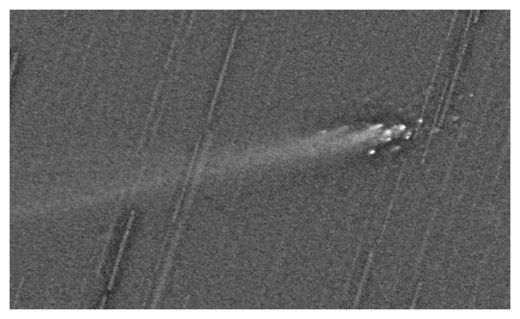
Unfortunately,
the likely demise of Comet Elenin hasn't put a lid on the doomsdayers
who have predicted earthquakes or three days of darkness or a collision
with Earth.
"The doomsdayers are just saying that more bad things will happen!"
laughed Musgrave. "But you have to remember that when a comet breaks up,
the fragments stay in the same orbit. If it evaporates, you'll have a
mass of rubble and gas on the same orbit. People don't seem to get that
space is big, really big, and when a comet breaks up it follows Newtons
Laws and the fragments will slowly draw apart, but over the timescale
that we see them, the difference will be so miniscule."
Sources: Conversation with Ian Musgrave, Astroblog, AstroBob, Southern Comets, STEREO
China: Huge Bubble Cloud over Beijing Skies Mystifies Observers
Photos were posted online of a mysteriously huge bubble cloud over
the skies of Beijing and surrounding areas Thursday, which raised
concerns and discussions among netizens.
"At first, it's relatively small and bright, the upper part is something
like a semi-circle, a spherical ring of light, it's obviously becoming
bigger and bigger then."
When the observation team set their instruments at the bubble, it
gradually became bigger and thinner. The entire occurrence lasted for
less than 15 minutes. Observers took pictures of the whole process and
posted them online.
Staff members at the Beijing Planetarium believe it was the same phenomenon after an analysis of time and space.
"Of course people had a lot of discussions, personally I think it's a kind of meteor or a phenomenon in terrestrial space."
Experts say the bubble cloud was unlikely a natural phenomenon. Judging
from the pictures, the bubble cloud was hundreds of miles away from
observers in Beijing.
Zhu Jin, Curator, Beijing Planetarium: "It must have been caused by human beings, not nature or other things like that."
In less than one day more than 100 comments were posted about the
unusual phenomenon. Many of those who commented said they had seen a
similar bubble cloud in the provinces of Shenyang, Shanxi, and Zhejiang.
A very bright meteor streaked across the skies of Atlanta Sunday night, NASA scientists revealed Monday.
NASA said that the meteor was "too bright for the all-sky camera in Cartersville to accurately determine the center of light."
The Meteoroid Environment Office reported the meteor's initial speed was around 23.6 km per second (52,800 mph).
The all-sky camera in Cartersville, Georgia, operated by NASA's Marshall
Space Flight Center in Huntsville, Ala., captured a video and photos of
the spectacular meteor.
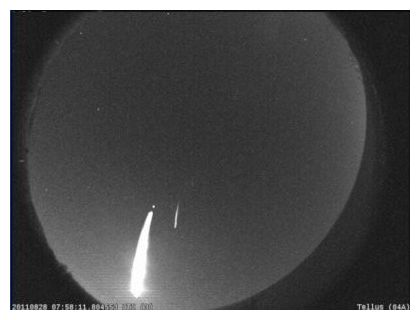
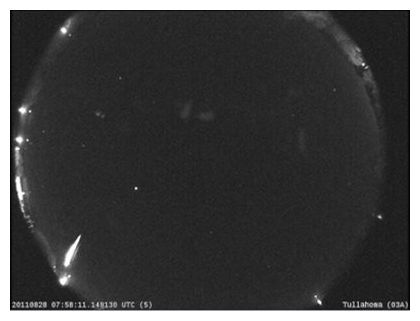
A YouTube video from NASA Marshall TV here shows the bright meteor captured from an all-sky camera in Cartersville.
Wales, UK: Cardiff student discovers two new asteroids
A stargazing schoolgirl made quite an impact on work experience when she discovered 22 new asteroids and a disintegrating comet.
Hannah Blyth, 18, had been chosen to do a summer work placement on the
University of Glamorgan's Faulkes Telescope project when she made the
remarkable finds.
The St John's College pupil single-handedly discovered two new
asteroids, and together with astronomer Nick Howes and two of the
world's leading comet and asteroid imagers, Giovanni Sostero and Ernesto
Guido, discovered 20 others - not to mention the comet.
"I was not really expecting to be involved with the asteroids, never
mind expecting to find new ones - and it was quite a rush, to tell the
truth," said Hannah, from Castleton, who is hoping for a career in
science.
"It was an extremely exciting moment when we discovered the asteroids,
and something to remember. I'm very proud of the fact that I was part of
something like that, I had a lot of fun."
She was encouraged by her biology teacher to go on the funded
placement as part of a programme by the Nuffield Foundation, working
with the team in charge of the Faulkes Telescope project.
The robotic telescope, based on the Hawaiian island of Maui and in
Australia, is operated remotely from computers, and Hannah shared her
remarkable discoveries with the rest of the team via Twitter.
"As soon as we saw the images, we knew something had kicked off in the comet's tail," said Mr Howes.
"We were frantically communicating with each other over Twitter, e-mail
and Facebook, just staggered with the huge fragment we were seeing
drifting back along the comet's tail."
The university said that it was "highly unusual" for an amateur to
discover such phenomena on their own, and "even more remarkable" for a
schoolgirl.
It follows on from Irish comedian Dara O'Briain sparking a Twitter
stargazing debate after operating the telescopes remotely from London
after tweeting with Dr Edward Gomez, from Cardiff University, who is
also involved with the Las Cumbres Observatory Global Telescope Network.
"This project, which we decided to squeeze in to the normally quiet
summer months when the telescopes are not being used by schools, has
been an amazing success", says Dr Paul Roche, head of astronomy at
Glamorgan and space ambassador for Wales.
"We had hoped to find maybe one or two new asteroids, but Nick, Giovanni
and Ernesto have turned up far more than that already, and Hannah's
observations of the comet fragmentation are really the icing on the
cake."
Vaibhav Sapra and Sharanjeet Singh of Bal Bharati Public School,
Pitampura, have discovered a Main Belt Asteroid, ensuring for themselves
a name in history.
Conducted by non-government organisation Science Popularisation
Association of Communicators and Educators (SPACE) in collaboration with
the United States-based International Astronomical Search
Collaboration, the All-India Asteroid Search Campaign-2011 concluded in
August. It involved school and college students from across the country
working with a special software to discover asteroids. The students,
divided into groups of two each, collaborated and analysed their data
for asteroid hunting. It was a difficult and challenging task for
Vaibhav and Sharanjeet, both Science students, to jointly detect the
asteroid from a series of pictures of the sky.
According to Sharanjeet, the three-month-long campaign involved
software training, studying and spotting moving objects on the
highly-advanced Astrometrica software. "We had to assume the shape of
the asteroid. For each image, there was a graph which we had to jointly
analyse and prepare a report."
Once the report was completed, the duo despatched it to renowned
astrophysicist and head of International Astronomical Search
Collaboration Miller Patrick.
Since there is an official confirmation of discovering "2011QM14," the
name of the new asteroid, both Vaibhav and Sharanjeet will now have to
wait till its orbit is completely known. "It will take three to six
years, and then we will be allowed to give it a name. We have not
decided the name yet," Sharanjeet said.
Reacting to his son's discovery, Rajeev Sapra, an executive engineer in
Delhi Transco Limited, said he is on cloud nine. "A couple of years ago,
I purchased a small telescope for my son. Last year, he wanted a bigger
telescope. I invested in it because astrophysics is Vaibhav's field of
specialisation."
Sixty school and colleges from different metropolises participated in the campaign.
The meteorite was spotted in the Andean city of Cusco, home of the Inca citadel Machu Picchu
He
spends most of his day at office and commuting to and from Mumbai in
crowded suburban trains but accountant Shishir Deshmukh still finds time
to look at the stars and pursue his passion for astronomy. And he has just discovered his sixth comet in just nine months, the first by an Indian.
His latest discovery was a Kreutz Group comet Thursday evening.
"I feel very thrilled by my discoveries, the first by an Indian. It
gives great pleasure. Although I am an amateur astronomer, I have made a
small contribution to the world of astronomy," an excited Deshmukh, who
works as an assistant accounts manager with a leading realty group,
told IANS.
The Kreutz Group of comets is named after a German astronomer, Heinrich
Kreutz, who discovered that these types of comets - which travel around
the sun and consist of a solid frozen nucleus part and a long luminous
tail - have their orbits very close to the sun.
"These comets are generally very fragile, barely a few metres long and
keep disintegrating throughout their orbit," explained Deshmukh, a
commerce graduate from the University of Mumbai with an M.Phil in
information science.
These comets are much smaller than the better known large comets like Halley's Comet.
"But they (the small ones) are very useful to the study of the dynamics
of orbits of comets, their disintegration process and perturbations from
giant planets," he added.
"Actually, what we are seeing now in the form of Kreutz Comets
is the debris or left-overs of very large comets which come in the
vicinity of our solar system once in a few centuries.
"From the orbits of some of the Kreutz Comets, it is estimated that one
such huge comet was seen in 1106, then in 1882 and last in 1965,"
Deshmukh, 37, explained.
Besides, some short period comets are also observed using Solar &
Heliospheric Observatory (SOHO) data, which help scientists understand
their orbital dynamics and rate of erosion each time they visit our
solar vicinity.
On the basis of their observations, astronomers can estimate their
expected time of return - and the possible risks to mankind, he said.
Detailing his achievement, Deshmukh said it involves a furiously
competitive study of images of the sun sent by SOHO, which is a space
observatory between the sun and earth, some 1.5 million km away from our
planet.
"It beams one image every 12 minutes which is uploaded on its official
website 24x7 and picked up by astronomers worldwide. I also studied
them, measured the positions of any suspicious objects, picked out my
claims and submitted them for confirmation, including the one yesterday
(Thursday)," he said.
"My latest discovery - yesterday evening - has also been acknowledged as
genuine and the official confirmation is expected soon," Deshmukh said.
The plaudits have been many.
Deshmukh was felicitated for his achievement by former president A.P.J. Abdul Kalam in Dombivali last March.
In January this year, Deshmukh, co-author of a book, Astronomy of Eclipses,
was commended and felicitated by eminent nuclear scientist Anil
Kakodkar for becoming the first Indian amateur astronomer to get
international recognition as a discoverer of SOHO comet.
He will speak on "Comet Hunting With SOHO" at a major felicitation
organised by the Bombay Amateur Astronomers Association Saturday.
In the past 15 years or so, a total of 2,122 Kreutz Group of comets have
been discovered by professional and amateur astronomers worldwide.
German astronomer Rainer Kracht holds a tally of 225 discoveries.
Other astronomers have made smaller individual discoveries, including Deshmukh, of course.
Prior to Deshmukh, late Indian astronomer M.K.V. Bappu of Andhra Pradesh
along with two international scientists, discovered a conventional
comet which was later named after them as 'Bappu-Bok-Newkirk Comet' in
1949.
On the night of August 20th, numerous people and pilots in both
Beijing and Shanghai reported seeing a strange ball of light that grew
bigger and bigger over the cities' skies. The topic has been creating
quite a lot of buzz among Chinese netizens, with many claiming that the
strange glow was actually a "Super UFO". Several pilots who were mid-air
at the time reported seeing a huge white ball flying at an altitude of
10.7km, one that appeared several hundred times larger than the moon.
The mysterious phenomenon was visible for 20 minutes and was reported to
the East China Air Traffic Control Bureau. As usual, no official
explanation for this mysterious sighting has been given.
Comet Double Feature: Comets Elenin & Garradd Now Showing in Night Sky

© Starry Night Software
Comet Garradd can be seen right now with binoculars in the constellation Sagitta.
Comet Garradd can be seen right now with binoculars in the constellation Sagitta.
Skywatchers often ask "When's the next comet?" In fact, if you're
prepared to do a bit of searching, there are always several comets
visible in the night sky, including two right now.
Some comets are like old friends, they keep coming back at regular intervals to visit. These are called periodic comets; Comet Halley was the first
such comet to be identified, by Edmond Halley back in 1705. It returns
to the inner solar system every 75 to 76 years; its last appearance was
in 1986 and its next will be in 2061. At present Halley is out just
beyond Neptune's orbit.
Other comets are one-time visitors: they come in to visit us from the
Oort Cloud, warm themselves for a few months by the sun, and then head
back out to the farthest reaches of the solar system.
There are two comets currently visiting the inner solar system - comet
Elenin and comet Garradd - so the next two months will provide some
excellent opportunities to observe these unusual visitors. The sky map of the two comets here shows their locations over the next few weeks.
All comets share one characteristic: they are like "dirty
snowballs" in their makeup. Their nucleus of rock and ice, when warmed
by the sun, sheds its ice which forms a graceful tail as it's swept away
by the solar wind. Because it's the solar wind that drives the gas and
vapor away, comet's tails always point away from the sun.
Comment: If comets were actually "dirty snowballs"
like this author claims, then why have all attempts to disturb the
surface of comets produced nothing but rock and dust?
Oh, I know what you're thinking, the water and ice must be trapped on
the inside and only "leaks out" to form the long comet tail, right?
Wrong. In fact, comet tails appear to be an entirely electric
phenomenon (why else would they only point in the direction of the solar
wind, for instance?) and the H20 observed within the tail is likely due to chemical processes brought on by powerful electric currents. As stated in our summary of James McCanney's theories on comets:
McCanney... hypothesizes a "recombination zone" around the comet nucleus
where the electrons neutralize incoming positive ions from the tail, making the region a "chemical factory" where elements are blended into molecules like water and hydrocarbons...
But in case you need more proof, this little video
should suffice to sum up the main points of why comets cannot possibly
be "dirty snowballs" as many mainstream astronomers have painted them to
be.
In the sky, many comets appear like ghostly fingers pointing down
towards Earth. That is one reason why comets have traditionally been
viewed as harbingers of death and disaster. To astronomers, on the
contrary, they are objects of great beauty and attract close scientific
scrutiny for the information they reveal about the ancient history of
the solar system and its farthest reaches.
Comet Elenin now showing
The first comet visitor in the sky we'll review is comet Elenin (C2010
X1). You may have heard about, because it's become a popular item for
the gloom and doom crowd, who see portents of disaster in ordinary
astronomical objects.
The truth about Comet Elenin
is that it is a quite ordinary, fairly small comet discovered on Dec.
10, 2010 by Russian amateur astronomer Leonid Elenin using a remote
controlled telescope in Arizona.
This comet will pass closest to the sun on Sept. 10 (45 million miles or
72 million kilometers) and closest to Earth on Oct. 16 at a distance of
22 million miles (35 million km.)
Despite the fact that this is a really tiny body, 3 or 4 km. in diameter which will miss the Earth by 22 million miles, the purveyors of gloom and doom
have seized upon it as bringing disaster upon the Earth. Please don't
take them seriously, instead try to spot this interesting little object.
Comment: The "purveyors of gloom and doom" have
certainly latched onto the buzz surrounding Comet Elenin, but we suspect
the situation is not so cut and dry:
Elenin, Nibiru, Planet-X - Time for a Sanity Check
At present, comet Elenin is too close to the sun to be viewed from
the Northern Hemisphere, though observers south of the equator may catch
it low in the western sky after sunset. Northern observers' turn will
come after the comet passes the sun and starts back out towards the Oort
Cloud.
In the last few days of September, Elenin will separate from the sun in
our morning sky. It will be visible in binoculars in the morning sky for
all of October, and we will publish finder maps then.
There is an unusual opportunity to "observe" this comet when it is very
close to the sun during the last week of September. To do this, you
won't be able to use your eyes or any optical aid; instead you will use
your computer.
Several times every day, the SOHO satellite returns images of the sun, including ones from the observatory's LASCO C3 camera
which has a field of view of about 15 degrees. This has an occulting
disk which blocks the Sun itself but lets the background stars appear.
If you take a look at it right now, you'll see Venus off to the left of
the sun and the star Regulus to the right. During the last week of
September, you will be able to see Comet Elenin pass through the field
of view.
Comet Garradd graces the sky
The other bright comet in the night sky hasn't received the publicity of
comet Elenin but is actually a better opportunity for skywatchers. This
is comet Garradd (C2009 P1), which was discovered on Aug. 13, 2009 by
Australian astronomer G. J. Garradd.
Comet Garradd is very easy for any experienced skywatcher to locate and
observe with binoculars. Currently it is just south of the small but
well-known constellation of Sagitta, the arrow. This arrow-shaped
constellation is right in the middle of the summer triangle formed by
the bright stars Vega, Deneb, and Altair. On Wednesday (Aug. 24),
Garradd was right under the tip of the arrow.
Tonight (Friday, Aug. 26), Garradd it will be impaled by the shaft of
the arrow, and one week later (Friday, Sept. 2) it will be right by the
"hook" of the popular Coathanger Cluster, also known as Brocchi's
Cluster. During that time it should increase in brightness from about
magnitude 8.2 to about magnitude 6.9, an easy object with binoculars.
The comet will continue moving westward and brightening until it reaches
magnitude 5.8 on September 16. Then it will begin to fade.
The sky map in this story shows the position of comet Garradd at 11 p.m. EDT each night from through Sept 2.
A reminder: All of the magnitudes given here for comets are estimates;
comet brightness is notoriously hard to predict. The comets may be
fainter than predicted or we may get lucky and get a couple of really
bright comets.
Editor's note: If you snap an amazing photo of Comet Elenin or Comet
Garradd, and would like to share them with SPACE.com for a possible
story or gallery, please contact managing editor Tariq Malik at:
tmalik@space.com.
Over the weekend, incoming Comet Garradd passed beautifully close to globular star cluster M71.
For all those amateur astronomers caught under hurricane clouds, John
Chumack of Dayton, Ohio, recorded the encounter in the form of a 2.5
hour time-lapse movie:
"It was so cool watching the comet's tail cross the cluster," says Chumack. "I had a great view through my home-made 16-inch telescope."
At the moment, Comet Garradd can only be seen through a backyard telescope (recommended: The Comet Hunter).
It is, however, approaching the sun and brightening. Recent projections
place it at peak magnitude 6, on the threshold of naked-eye visibility,
in February 2012. Because Comet Garradd is a first-time visitor to the
inner solar system, it could behave in unexpected ways, perhaps
exceeding those expectations. Stay tuned--and meanwhile browse the image
links below.
More Images
From Daniele Cipollina of Arquata Scrivia, Alessandria, Italy; from Nick Howes of Cherhill in Wiltshire UK; from Ulf Petersson of Öland, Sweden; from Doug Zubenel of Linn Co., Kansas; from Marek Harman of Vartovka observatory, Banská Bystrica, Slovakia; from Karl Beck of Observatory Michelbach, Austria; from Jimmy Westlake of Stagecoach, Colorado; from Marian Urbaník of Čadca, Slovak republic; from Becky Ramotowski of Tijeras, New Mexico.
Comet Links:
Finder charts, 3D orbit.
A strange light filmed in the sky over Auckland on Saturday night was
probably not a UFO, comet, or rogue planet about to smash into Earth,
astronomers say.
The descending point of light, which revealed a U-shaped nimbus when
zoomed in on, was filmed in the sky west of Auckland about 6pm on
Saturday.
The video was uploaded to YouTube by a user known as biggordy100 who
narrates that the light is "back", indicating he has seen it in the
past.
The tag-line on the video reads: "WTF is in our skies? ufo! nibiru? elenin? spaceship? comet? seen over Auckland at 18.00."
Nibiru is the name given by Doomsday and conspiracy blogs and websites
to a supposed collision between Earth and a mystery planet - Planet X -
that is supposed to occur in the early 21st Century.
According to Wikipedia, Nibiru was revealed to Wisconsin woman
Nancy Lieder after aliens implanted a communications device in her
brain.
Comet Elenin has a similar conspiracy theory attached to it - something
about it actually being a secret brown dwarf star that is going to flip
the Earth's magnetic polarity with disastrous results.
Astronomers who could be bothered have debunked both theories.
Astronomy educator at Auckland's Stardome Observatory, David Britten,
said Nibiru would not hit Earth "because it doesn't exist".
He said the light that had been filmed was "almost certainly the contrails of a plane heading out over the Tasman Sea".
Britten said at that time, the sun had set enough for Auckland to be in shadow but the plane was still in the sun.
Its spreading contrail was catching the light and making the effect recorded.
Britten said the observatory was approached about similar sights semi-regularly.
"Look at the coverage over Hurricane Irene - if there was something out
there that was going to hurt us, we would know about it.''
He said if the videographer had waited for dark, with a telescope he
might have seen Saturn and its rings in approximately the same spot.
Comment: This article is a good example of how
unsubstantiated theories based on lies and ignorance lead to even more
ignorance, ridicule and faulty science. It's true that Nibiru and Comet
Elenin hysteria is blown way out of proportions, but the following
statement "if there was something out there that was going to hurt us,
we would know about it" clearly demonstrates astronomers' lack of
knowledge when it comes to threats from space or PTB's effort to conceal
them.
Read the following articles to learn more on the topic:
The Hazard to Civilization from Fireballs and Comets
Forget About Global Warming: We're One Step From Extinction!
Elenin, Nibiru, Planet-X - Time for a Sanity Check
Cosmic Propaganda Alert! Comet Elenin: Just Passing By - With SOTT Commentary
Comet Elenin Could Be Disintegrating
Astronomers
monitoring Comet Elenin have noticed the comet has decreased in
brightness the past week, and the coma is now elongating and diffusing.
Some astronomers predict the comet will disintegrate and not survive
perihelion, its closest approach to the Sun.
On August 19, a massive solar flare and coronal mass ejection hit the
comet, which may have been the beginning of the end for the much
ballyhooed lump of ice and dirt.

© NASA/STEREO
Comet Elenin as seen by the STEREO HI1-B on Aug. 6, 2011, from about 7 million kilometers from the spacecraft.
Comet Elenin as seen by the STEREO HI1-B on Aug. 6, 2011, from about 7 million kilometers from the spacecraft.
We've
been following it in the STEREO spacecraft images and a number of
amateurs have been following it in their telescopes," said Australian
amateur astronomer Ian Musgrave, author of the Astroblog website.
"Shortly after the coronal mass ejection the comet flared up and you
could see some beautiful details in the tail, with the tail was twisting
about in the solar wind. But shortly after that Earth- bound amateurs
reported a huge decrease in the intensity of the comet. We think it may
presage a falling apart of the comet."
One journalist joked that maybe Comet Elenin just couldn't take all the doomsday talk and publicity.
"It really has been a beautiful little comet and it deserves a better fate than to be overhyped by doom-sayers," said Musgrave.
Elenin is a long period comet originating from the outer edges
of our solar system, and Musgrave noted that comets coming from the Oort
cloud which are making their first pass through the solar system tend
to be under-performers in terms of brightness. "They don't brighten as
quickly as comets that come around more than once," he said, "and in
looking at the relationship between the brightness and the distance from
the Sun, we find empirically that comets that brighten on roughly the
same speed as Elenin tend to be likely to fall apart at perihelion."
However, Musgrave added, each comet is unique. "Some comets will survive
and some won't. The fact that this comet decreased in brightness after
the CME, possibly indicates that the comet will not survive. Another
possibility is that merely the CME wiped away the coma - the bright
cloud of particles around the comet - and the volatiles of the comet
might take awhile to come back and recreate the coma, if it does
survive."
Elenin's mass is smaller than average and its trajectory will take it no
closer than 34 million km (21 million miles) of Earth as it circles the
Sun. It will make its closest approach to Earth on October 16th, but be
closest to the Sun on Sept. 10.
Another Australian amateur Michael Mattiazzo has been taking images of the comet (see his website, Southern Comets)
and he has noticed that the nucleus appears to be elongating. When that
occurs, usually the comet disintegrates or splits apart. Here is an animation Mattiazzo created from images he took of Comet Elenin on August 19, 22, 23, 27 & 29.
You can see a wide-field view of the comet by astrophotographer Rob Kaufmanns, comparing the view from August 19, 23 and 26 at this link.
A similar process took place just a few weeks ago with another comet, 213P Van Ness.
Do comets break apart often?
"You don't see it it that often, but it happens surprisingly more than
people think," Musgrave said. "Van Ness just happened, but ever couple
of years there is a comet that visibly breaks up into fragments, maybe
about 6 comets in the last 10 years - excluding the Kreutz-sun-grazer
family of comets which split and vaporize on a regular basis."

© ESO
A closeup photo of the breakup of Comet S4 LINEAR taken on August 6, 2000 by the European Very Large Telescope (VLT) in Chile.
A closeup photo of the breakup of Comet S4 LINEAR taken on August 6, 2000 by the European Very Large Telescope (VLT) in Chile.
Unfortunately,
the likely demise of Comet Elenin hasn't put a lid on the doomsdayers
who have predicted earthquakes or three days of darkness or a collision
with Earth.
"The doomsdayers are just saying that more bad things will happen!"
laughed Musgrave. "But you have to remember that when a comet breaks up,
the fragments stay in the same orbit. If it evaporates, you'll have a
mass of rubble and gas on the same orbit. People don't seem to get that
space is big, really big, and when a comet breaks up it follows Newtons
Laws and the fragments will slowly draw apart, but over the timescale
that we see them, the difference will be so miniscule."
Sources: Conversation with Ian Musgrave, Astroblog, AstroBob, Southern Comets, STEREO
China: Huge Bubble Cloud over Beijing Skies Mystifies Observers
Photos were posted online of a mysteriously huge bubble cloud over
the skies of Beijing and surrounding areas Thursday, which raised
concerns and discussions among netizens.
"At first, it's relatively small and bright, the upper part is something
like a semi-circle, a spherical ring of light, it's obviously becoming
bigger and bigger then."
When the observation team set their instruments at the bubble, it
gradually became bigger and thinner. The entire occurrence lasted for
less than 15 minutes. Observers took pictures of the whole process and
posted them online.
Staff members at the Beijing Planetarium believe it was the same phenomenon after an analysis of time and space.
"Of course people had a lot of discussions, personally I think it's a kind of meteor or a phenomenon in terrestrial space."
Experts say the bubble cloud was unlikely a natural phenomenon. Judging
from the pictures, the bubble cloud was hundreds of miles away from
observers in Beijing.
Zhu Jin, Curator, Beijing Planetarium: "It must have been caused by human beings, not nature or other things like that."
In less than one day more than 100 comments were posted about the
unusual phenomenon. Many of those who commented said they had seen a
similar bubble cloud in the provinces of Shenyang, Shanxi, and Zhejiang.
A very bright meteor streaked across the skies of Atlanta Sunday night, NASA scientists revealed Monday.
NASA said that the meteor was "too bright for the all-sky camera in Cartersville to accurately determine the center of light."
The Meteoroid Environment Office reported the meteor's initial speed was around 23.6 km per second (52,800 mph).
The all-sky camera in Cartersville, Georgia, operated by NASA's Marshall
Space Flight Center in Huntsville, Ala., captured a video and photos of
the spectacular meteor.

© NASA/MSFC/Meteoroid Environment Office
View of meteor from all sky camera located at Cartersville, Georgia.
View of meteor from all sky camera located at Cartersville, Georgia.

© NASA/MSFC/Meteoroid Environment Office
View of meteor from all sky camera located at Tullahoma, Tenn.
View of meteor from all sky camera located at Tullahoma, Tenn.
A YouTube video from NASA Marshall TV here shows the bright meteor captured from an all-sky camera in Cartersville.
Wales, UK: Cardiff student discovers two new asteroids
A stargazing schoolgirl made quite an impact on work experience when she discovered 22 new asteroids and a disintegrating comet.
Hannah Blyth, 18, had been chosen to do a summer work placement on the
University of Glamorgan's Faulkes Telescope project when she made the
remarkable finds.
The St John's College pupil single-handedly discovered two new
asteroids, and together with astronomer Nick Howes and two of the
world's leading comet and asteroid imagers, Giovanni Sostero and Ernesto
Guido, discovered 20 others - not to mention the comet.
"I was not really expecting to be involved with the asteroids, never
mind expecting to find new ones - and it was quite a rush, to tell the
truth," said Hannah, from Castleton, who is hoping for a career in
science.
"It was an extremely exciting moment when we discovered the asteroids,
and something to remember. I'm very proud of the fact that I was part of
something like that, I had a lot of fun."
She was encouraged by her biology teacher to go on the funded
placement as part of a programme by the Nuffield Foundation, working
with the team in charge of the Faulkes Telescope project.
The robotic telescope, based on the Hawaiian island of Maui and in
Australia, is operated remotely from computers, and Hannah shared her
remarkable discoveries with the rest of the team via Twitter.
"As soon as we saw the images, we knew something had kicked off in the comet's tail," said Mr Howes.
"We were frantically communicating with each other over Twitter, e-mail
and Facebook, just staggered with the huge fragment we were seeing
drifting back along the comet's tail."
The university said that it was "highly unusual" for an amateur to
discover such phenomena on their own, and "even more remarkable" for a
schoolgirl.
It follows on from Irish comedian Dara O'Briain sparking a Twitter
stargazing debate after operating the telescopes remotely from London
after tweeting with Dr Edward Gomez, from Cardiff University, who is
also involved with the Las Cumbres Observatory Global Telescope Network.
"This project, which we decided to squeeze in to the normally quiet
summer months when the telescopes are not being used by schools, has
been an amazing success", says Dr Paul Roche, head of astronomy at
Glamorgan and space ambassador for Wales.
"We had hoped to find maybe one or two new asteroids, but Nick, Giovanni
and Ernesto have turned up far more than that already, and Hannah's
observations of the comet fragmentation are really the icing on the
cake."
Vaibhav Sapra and Sharanjeet Singh of Bal Bharati Public School,
Pitampura, have discovered a Main Belt Asteroid, ensuring for themselves
a name in history.
Conducted by non-government organisation Science Popularisation
Association of Communicators and Educators (SPACE) in collaboration with
the United States-based International Astronomical Search
Collaboration, the All-India Asteroid Search Campaign-2011 concluded in
August. It involved school and college students from across the country
working with a special software to discover asteroids. The students,
divided into groups of two each, collaborated and analysed their data
for asteroid hunting. It was a difficult and challenging task for
Vaibhav and Sharanjeet, both Science students, to jointly detect the
asteroid from a series of pictures of the sky.
According to Sharanjeet, the three-month-long campaign involved
software training, studying and spotting moving objects on the
highly-advanced Astrometrica software. "We had to assume the shape of
the asteroid. For each image, there was a graph which we had to jointly
analyse and prepare a report."
Once the report was completed, the duo despatched it to renowned
astrophysicist and head of International Astronomical Search
Collaboration Miller Patrick.
Since there is an official confirmation of discovering "2011QM14," the
name of the new asteroid, both Vaibhav and Sharanjeet will now have to
wait till its orbit is completely known. "It will take three to six
years, and then we will be allowed to give it a name. We have not
decided the name yet," Sharanjeet said.
Reacting to his son's discovery, Rajeev Sapra, an executive engineer in
Delhi Transco Limited, said he is on cloud nine. "A couple of years ago,
I purchased a small telescope for my son. Last year, he wanted a bigger
telescope. I invested in it because astrophysics is Vaibhav's field of
specialisation."
Sixty school and colleges from different metropolises participated in the campaign.

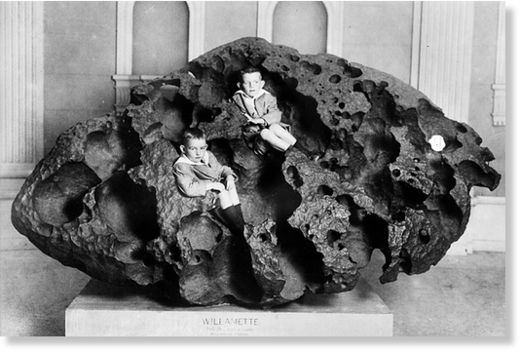
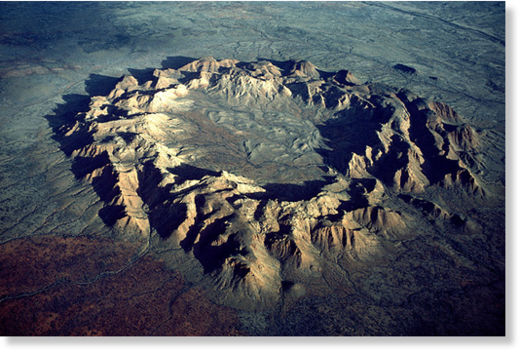
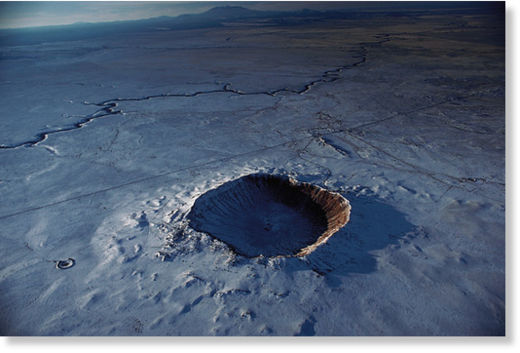
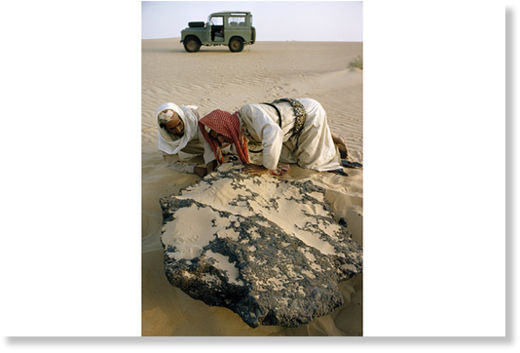
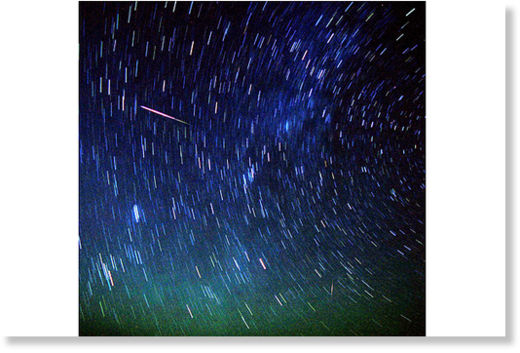
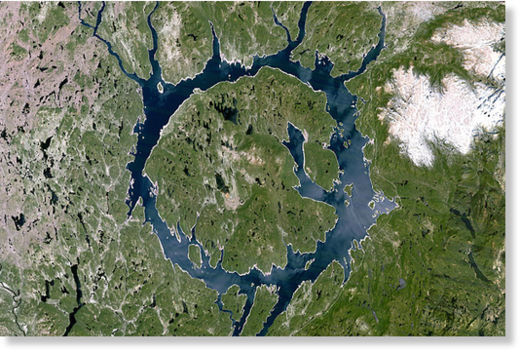
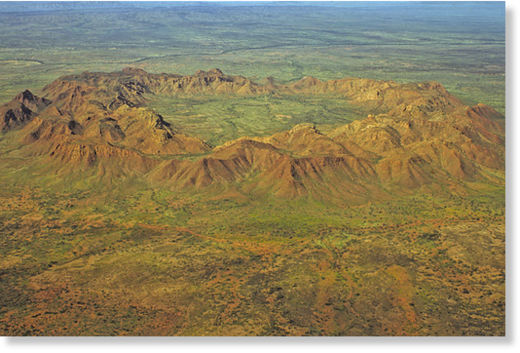
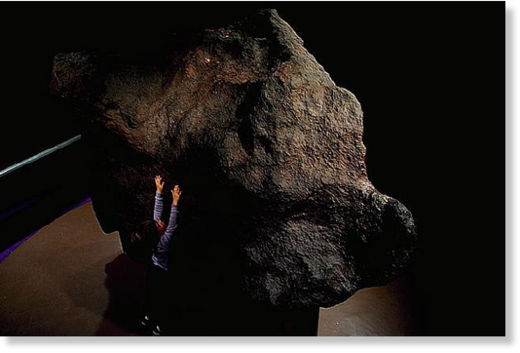
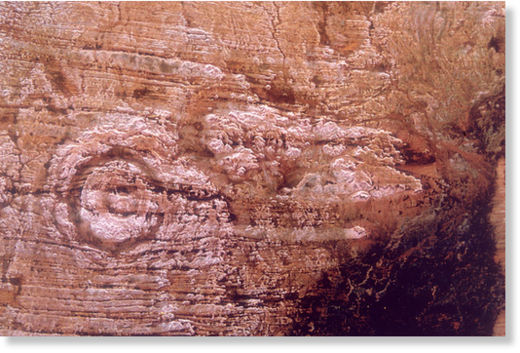
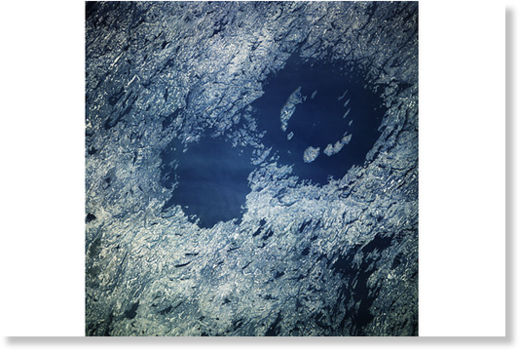
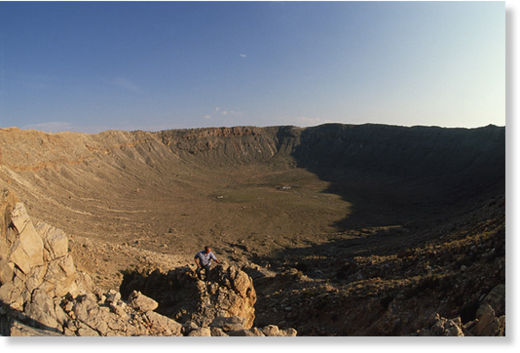


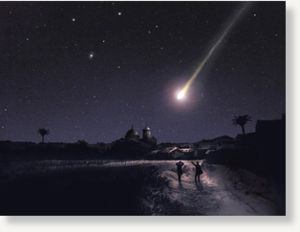
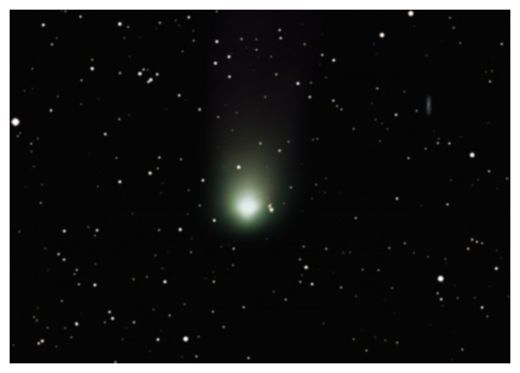

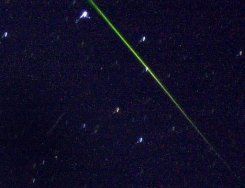
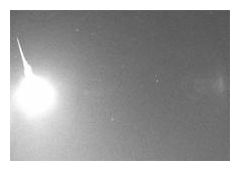
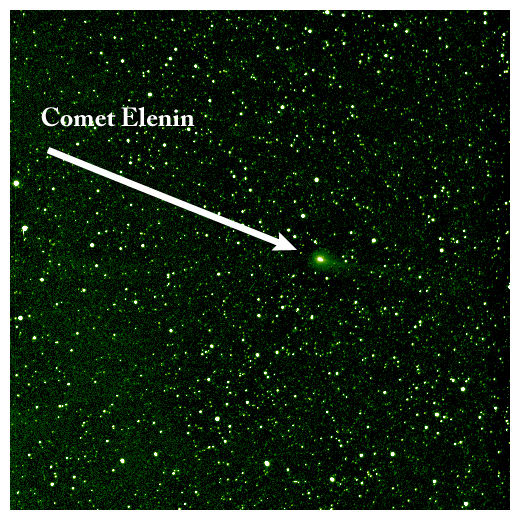

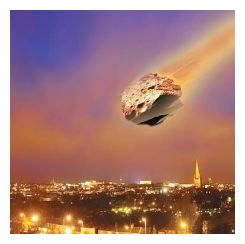
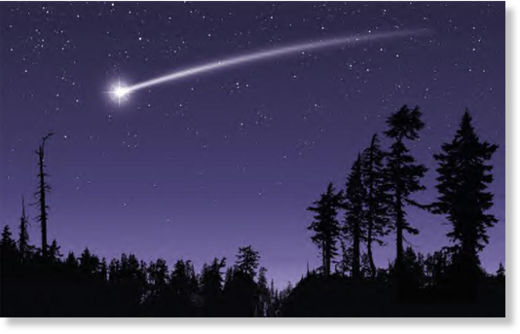

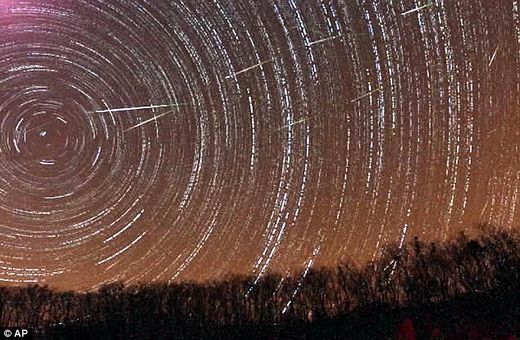
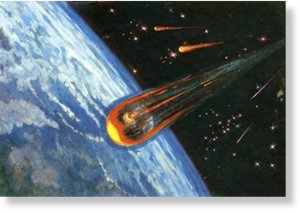
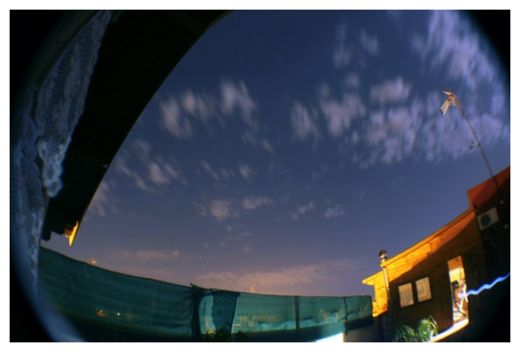
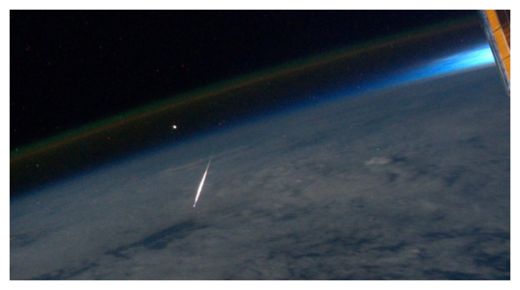

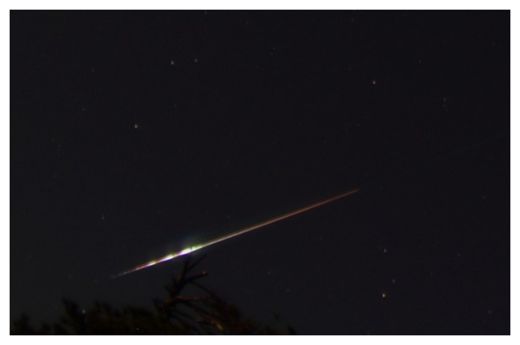
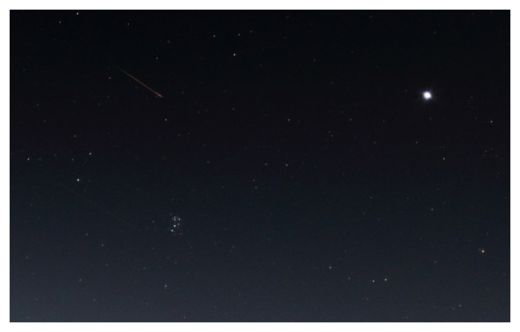
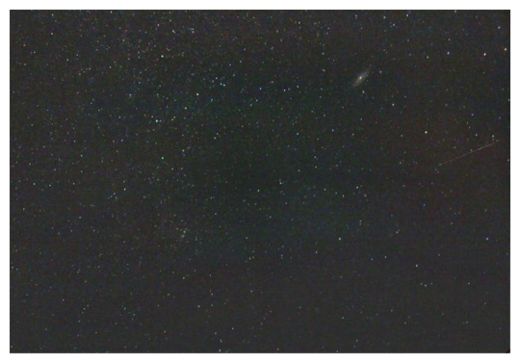
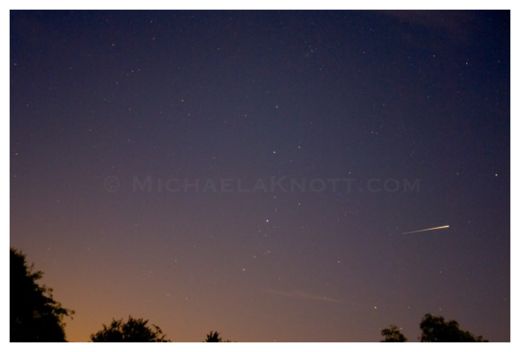



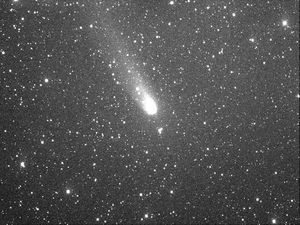
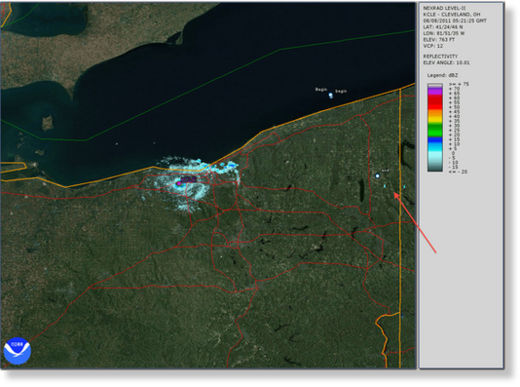

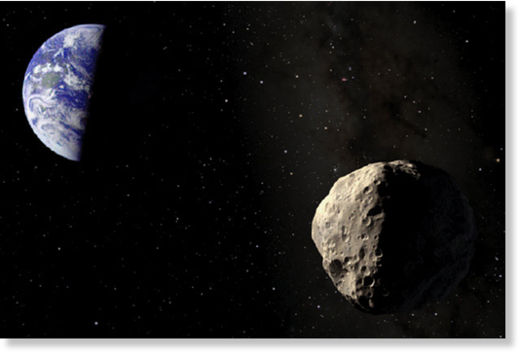
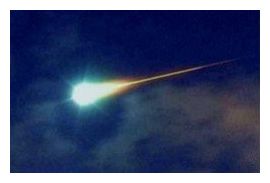
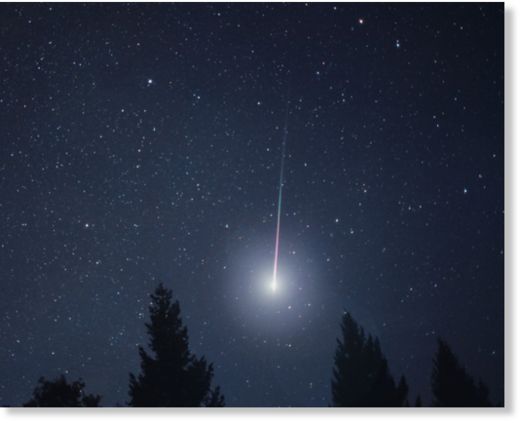
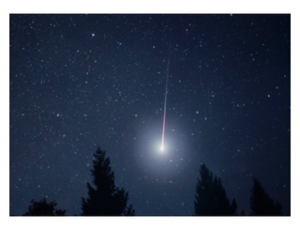
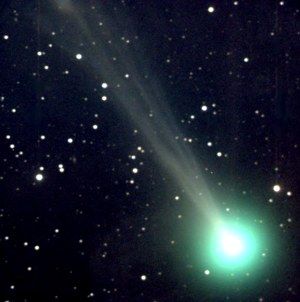
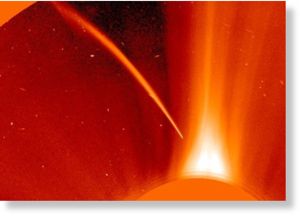
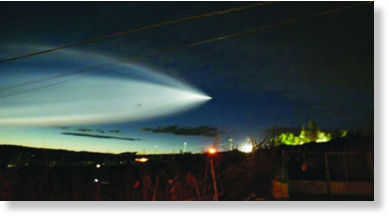
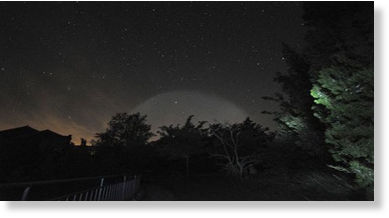
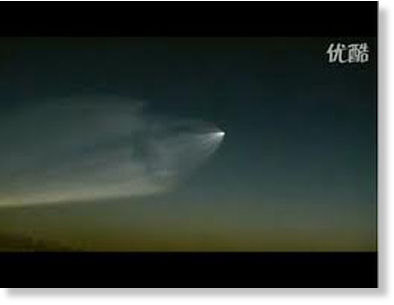
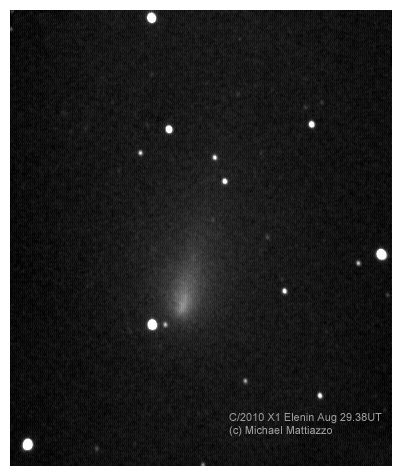
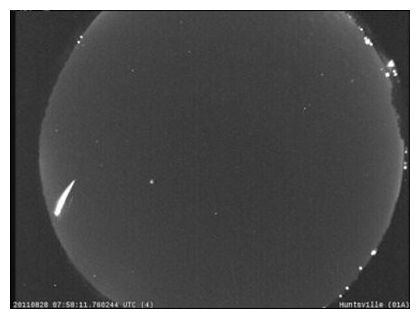

No comments:
Post a Comment